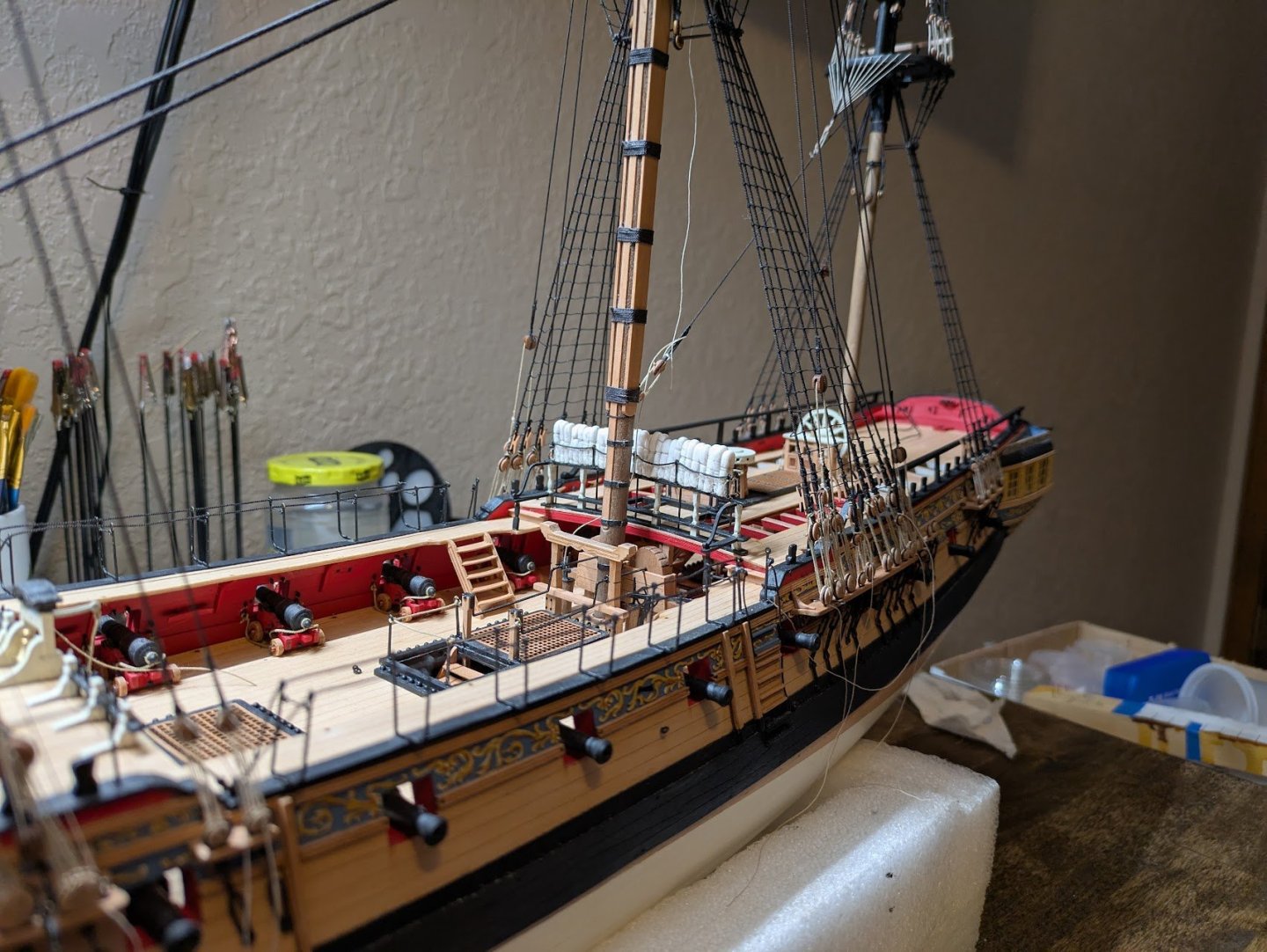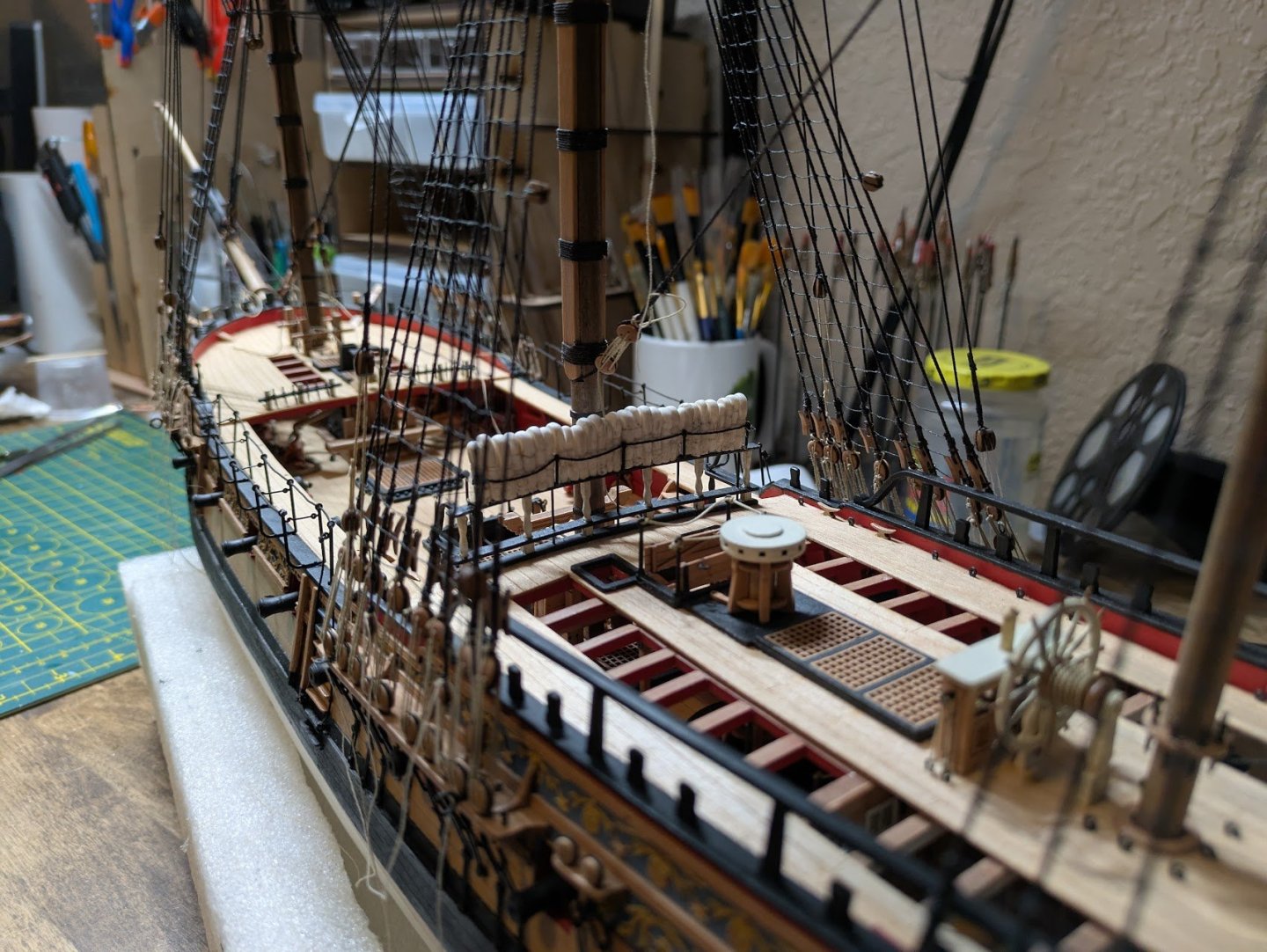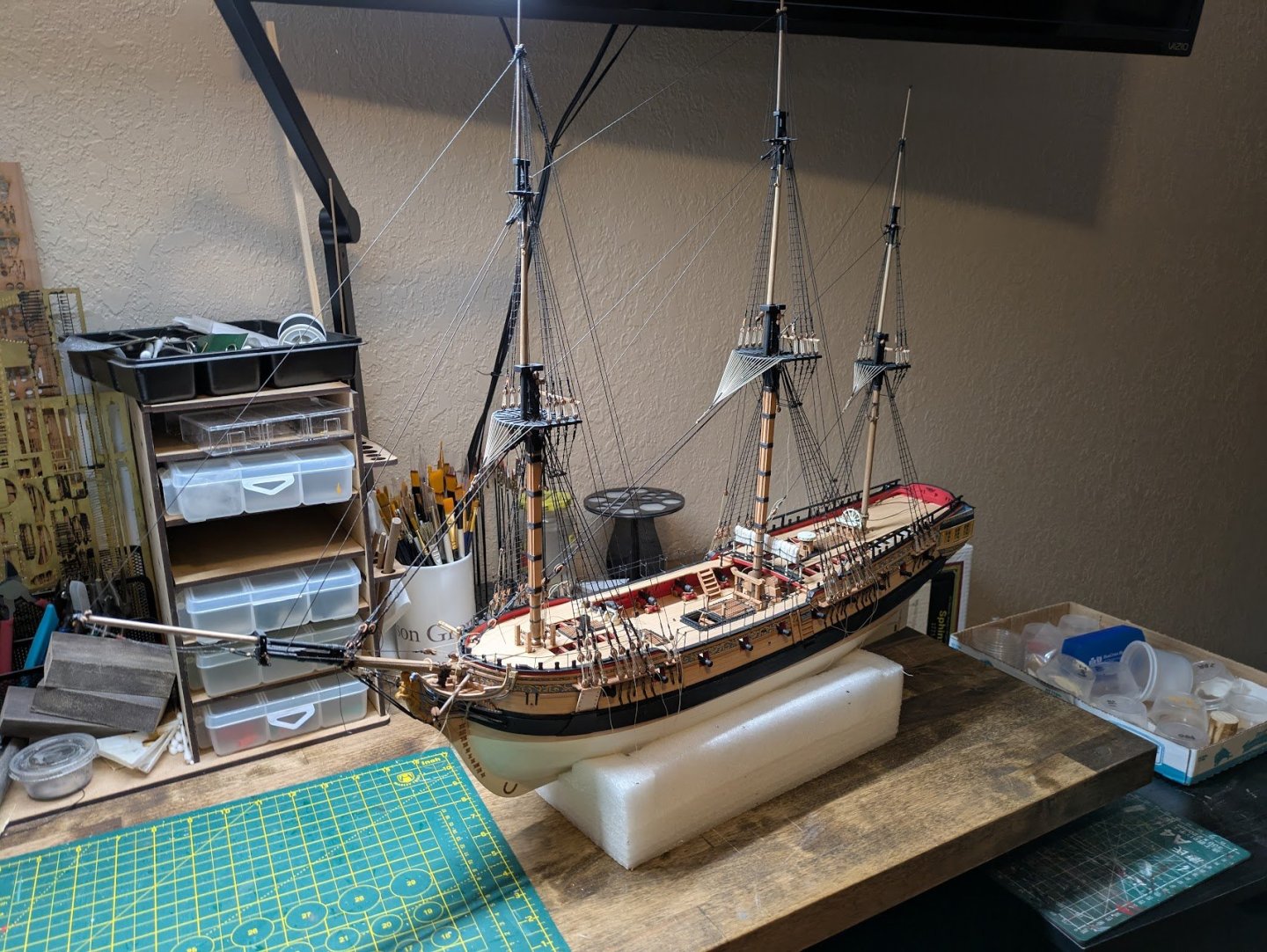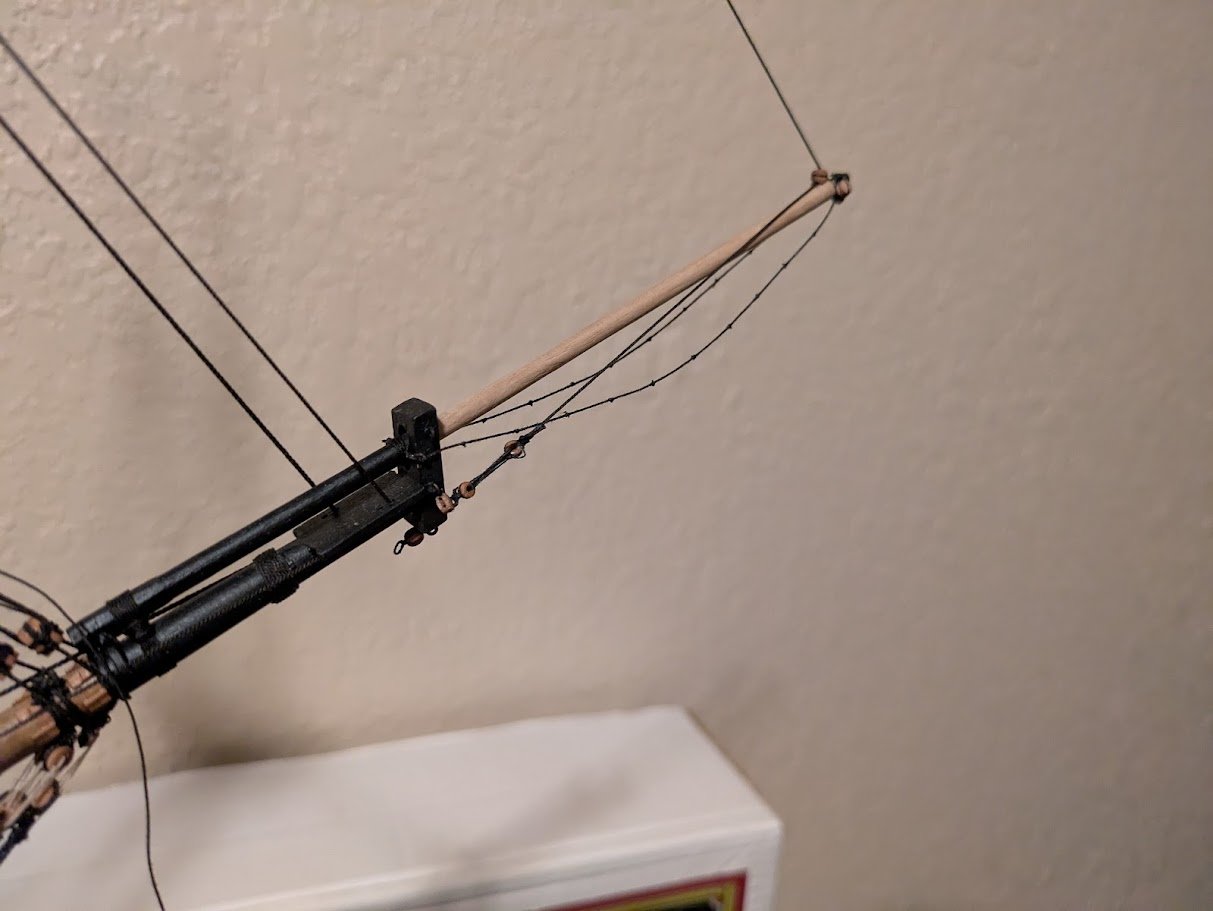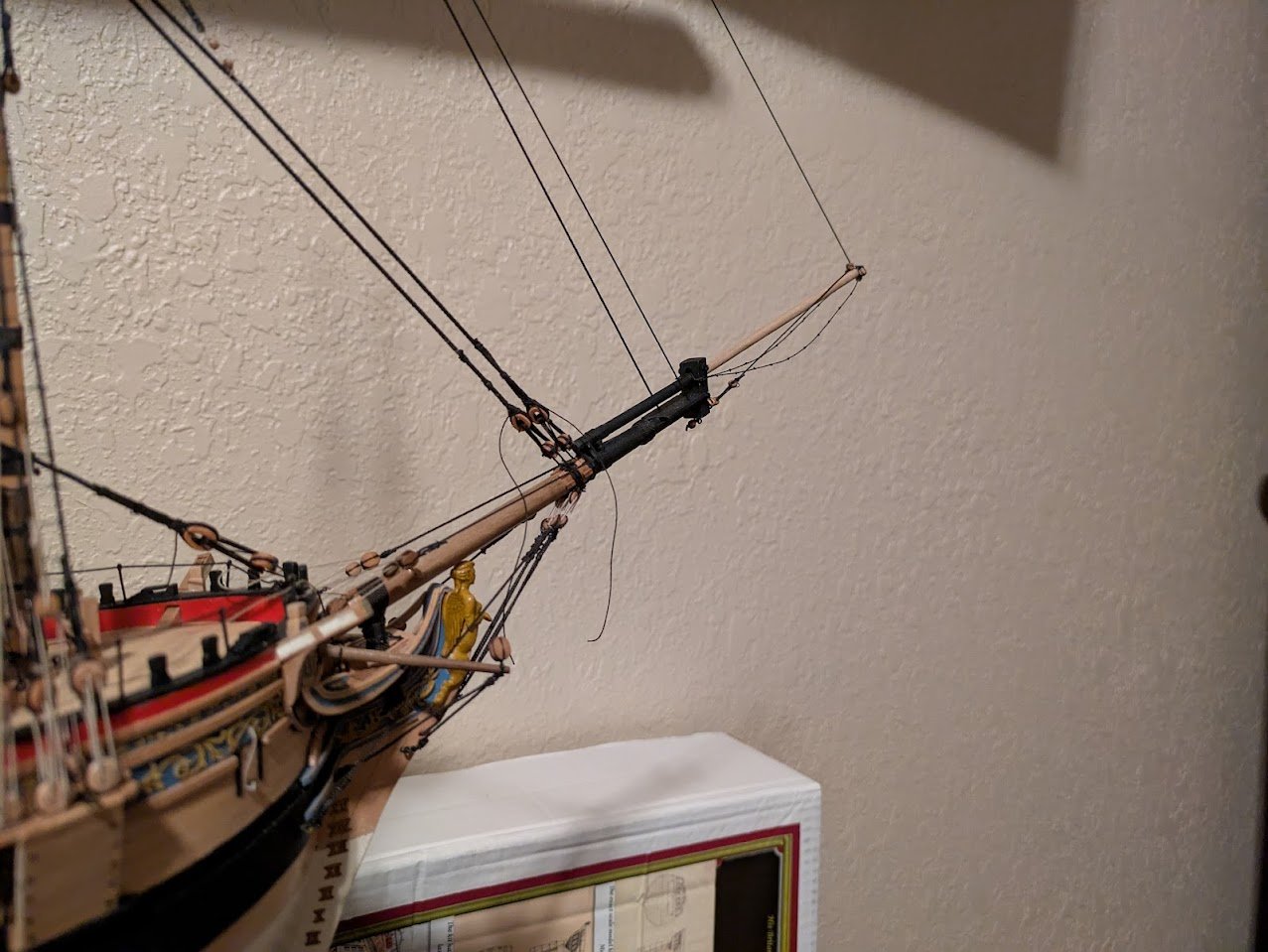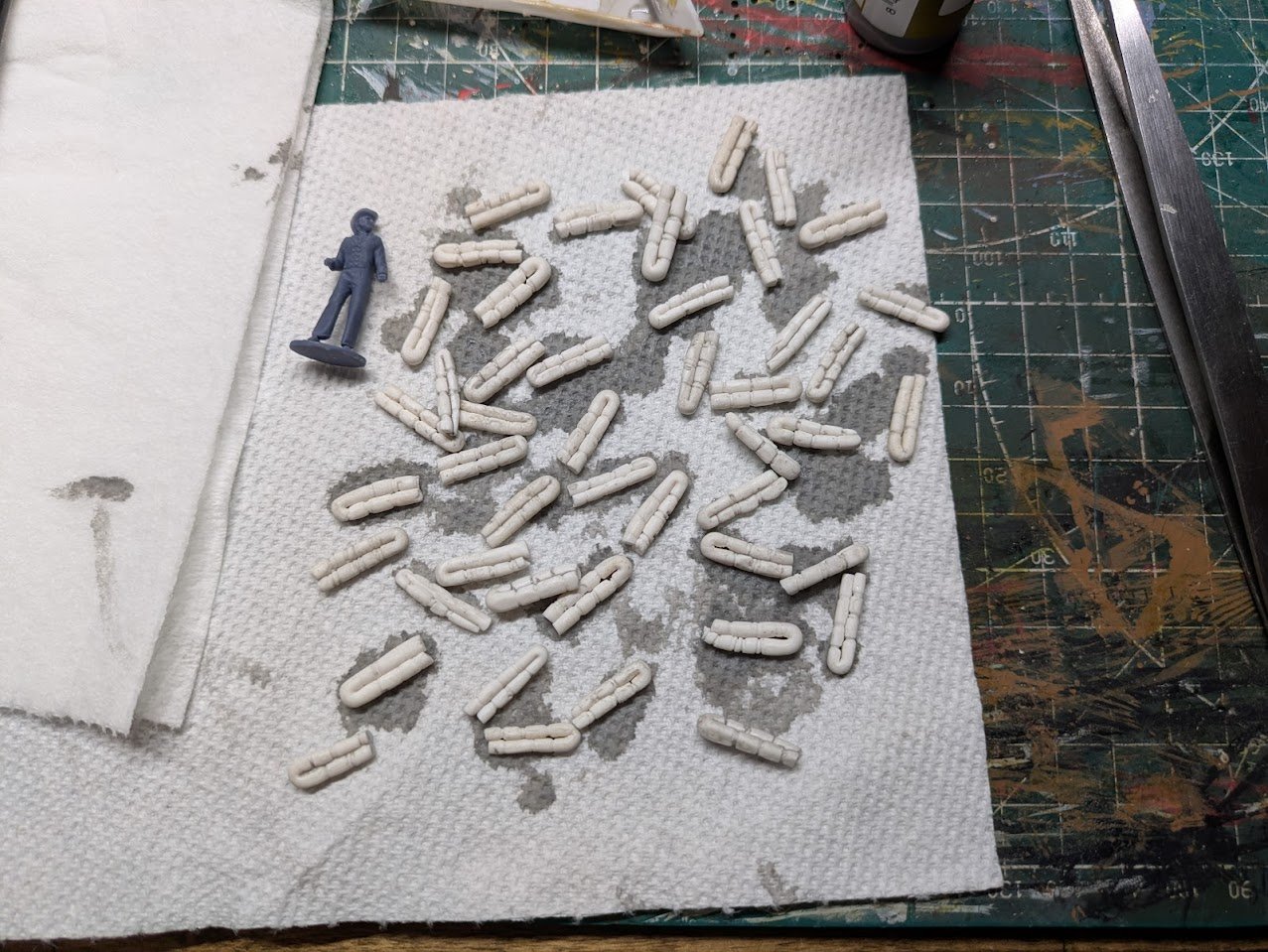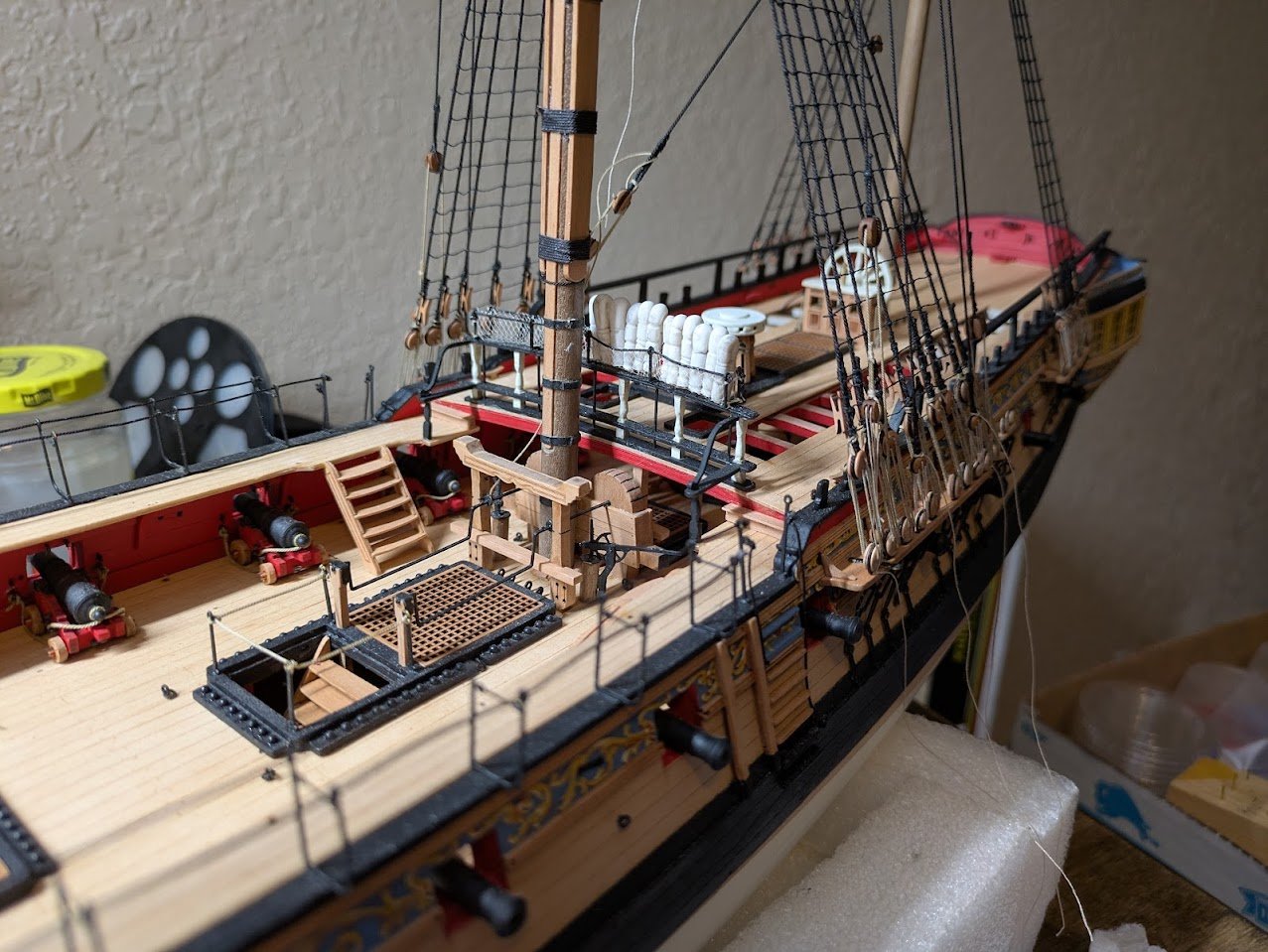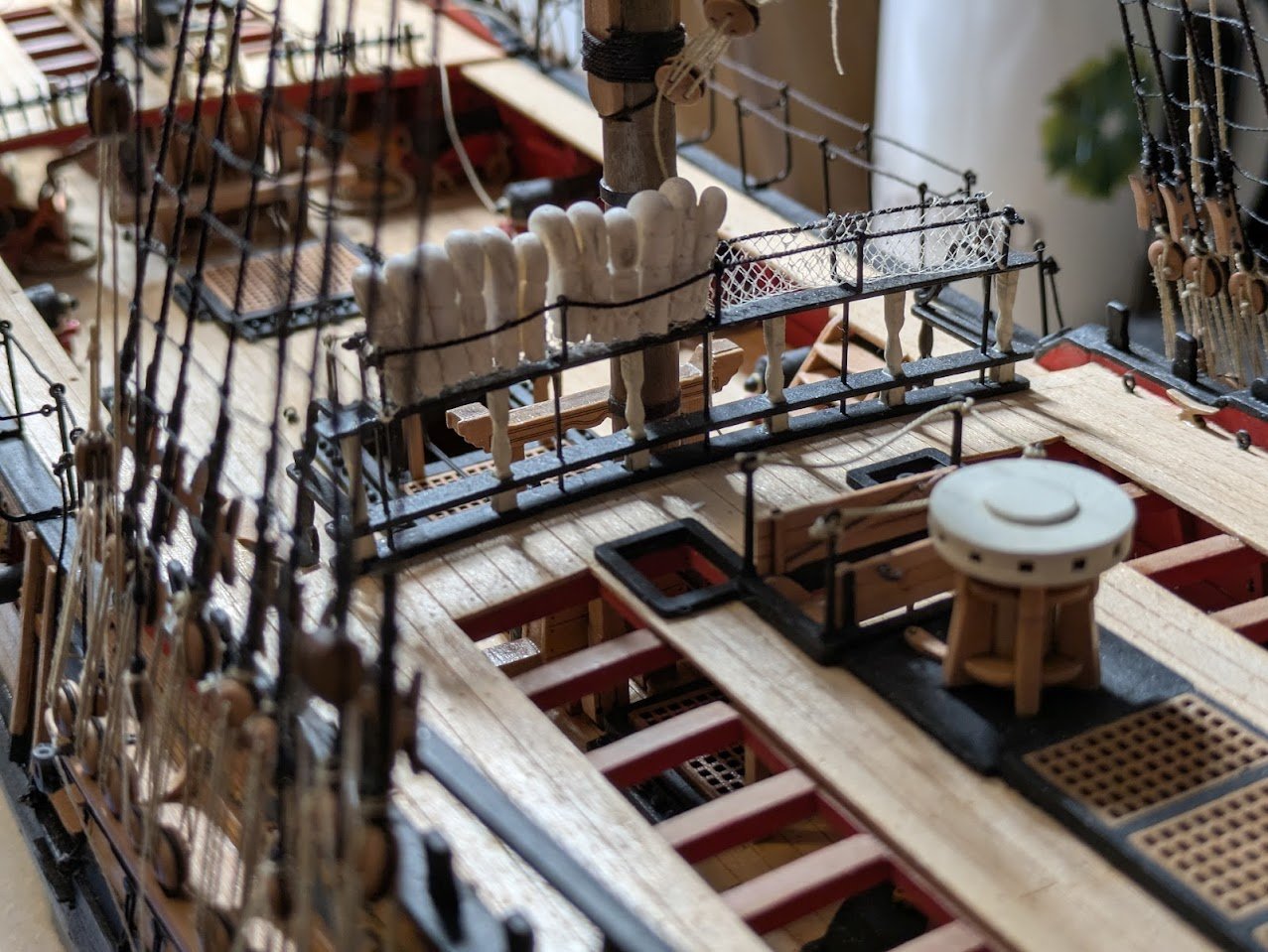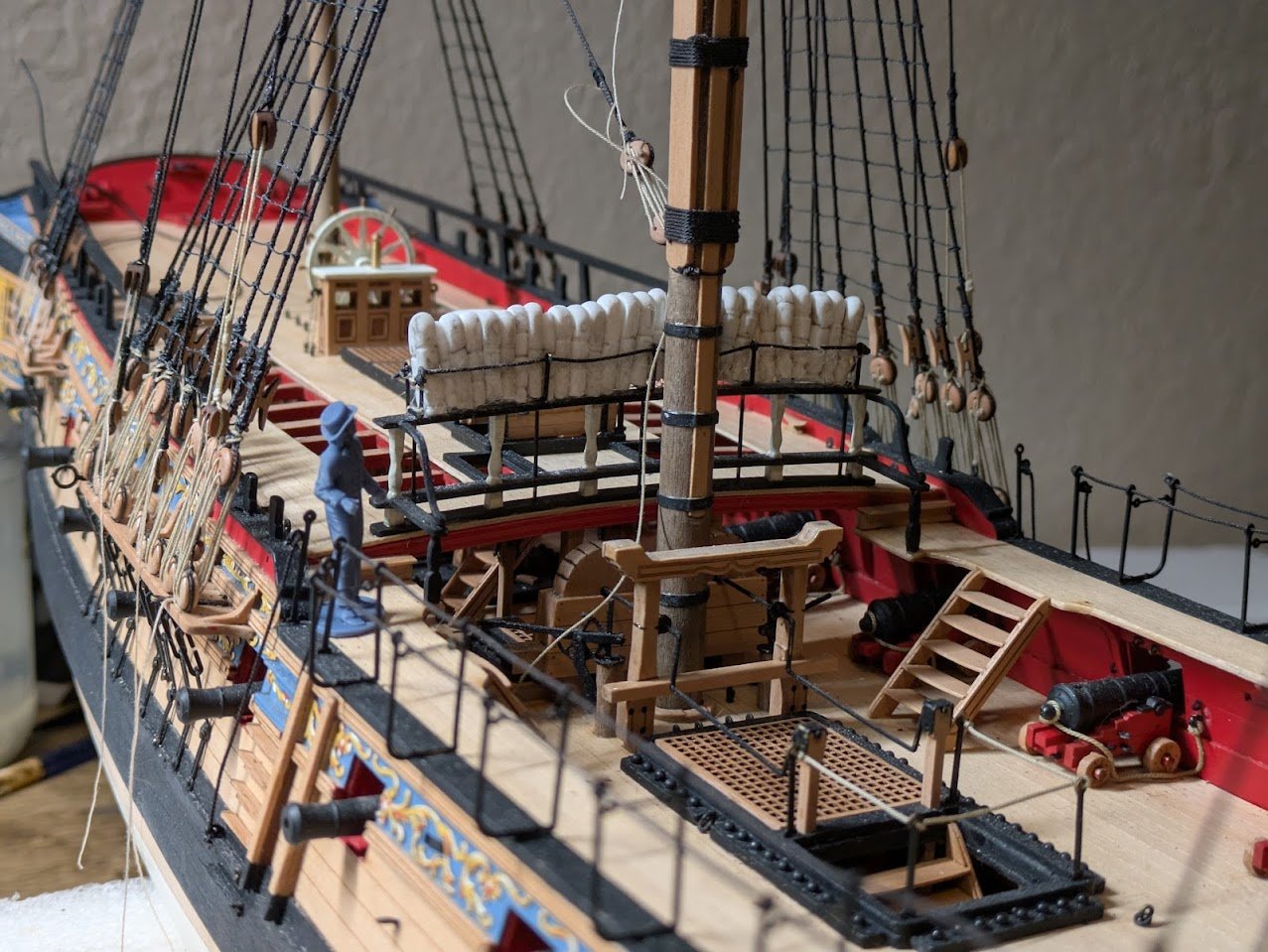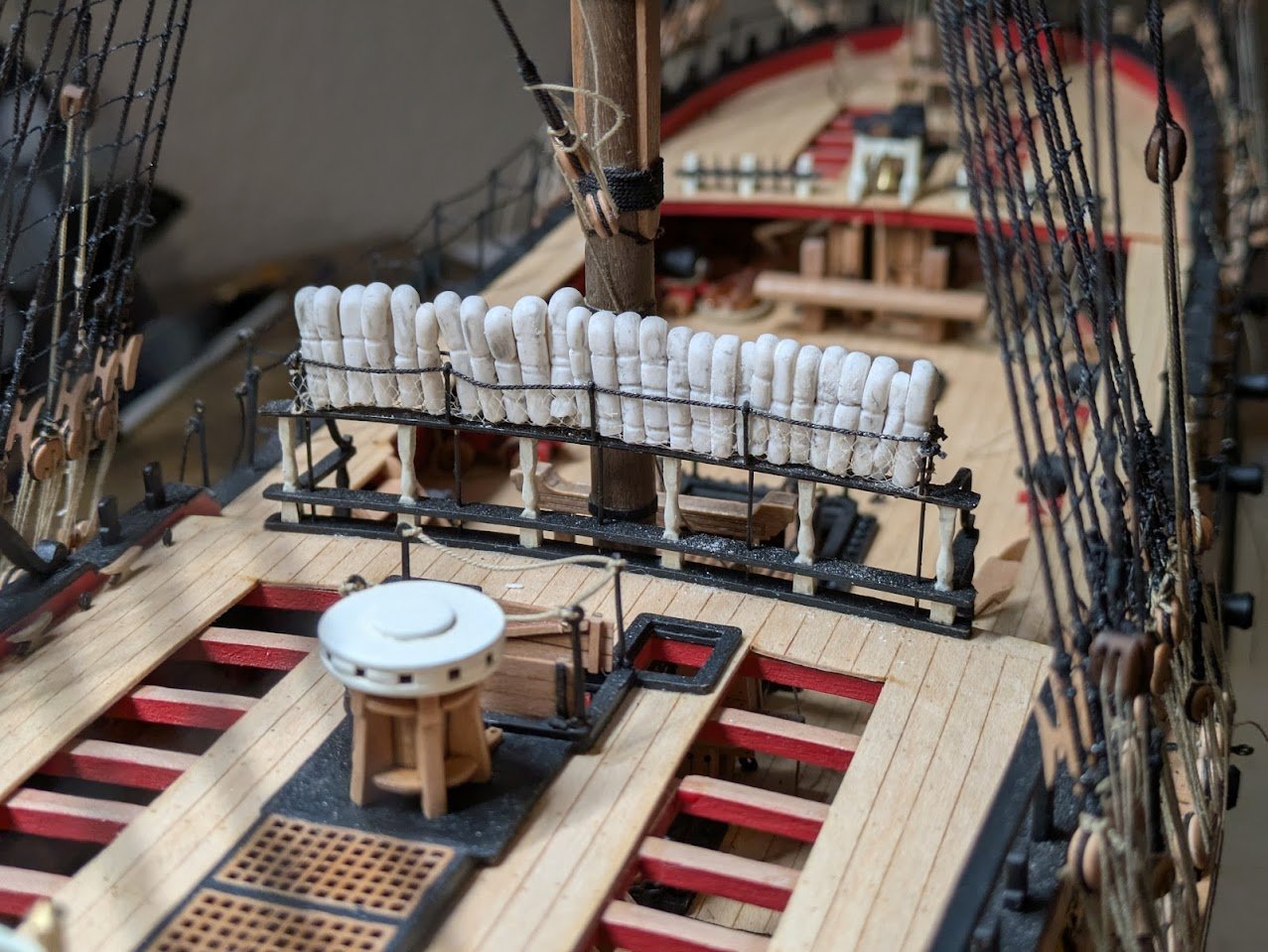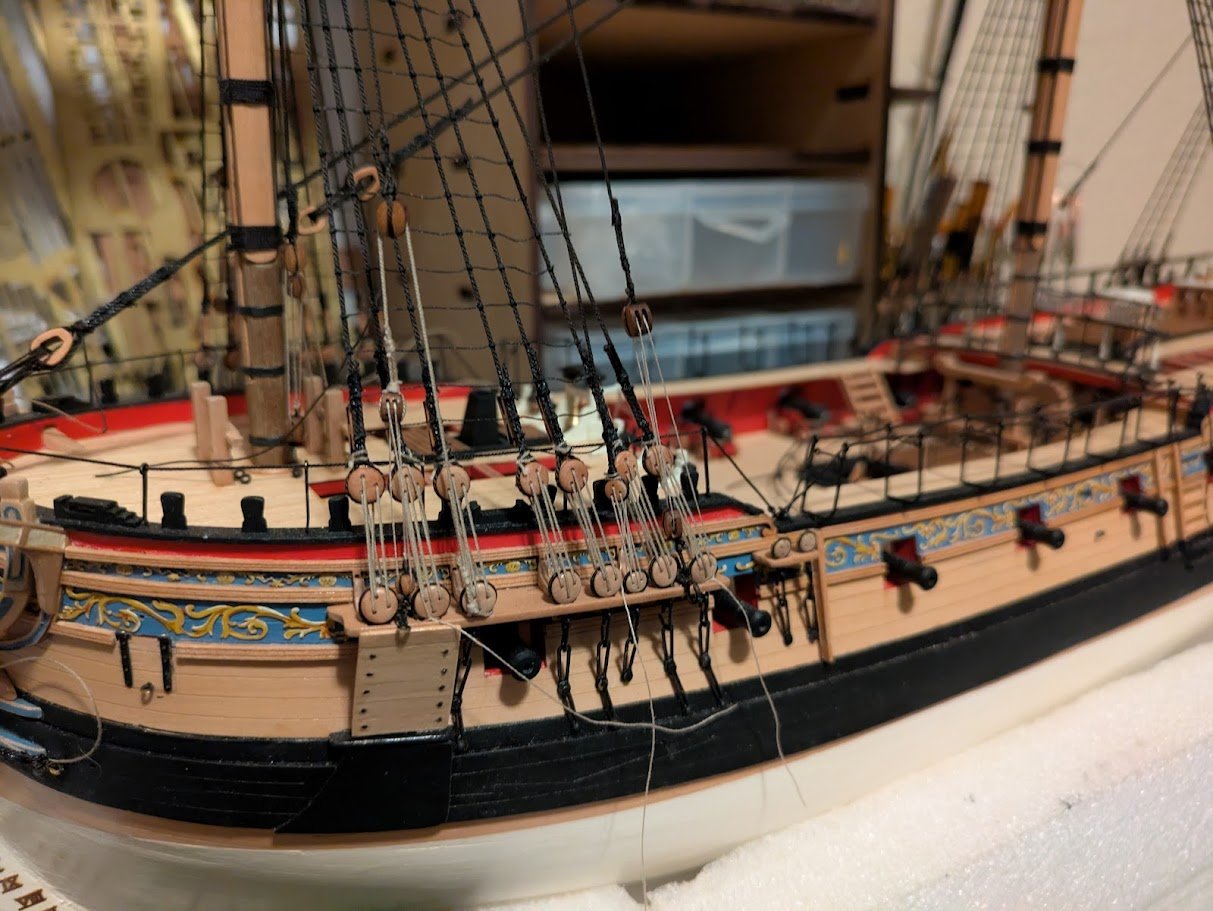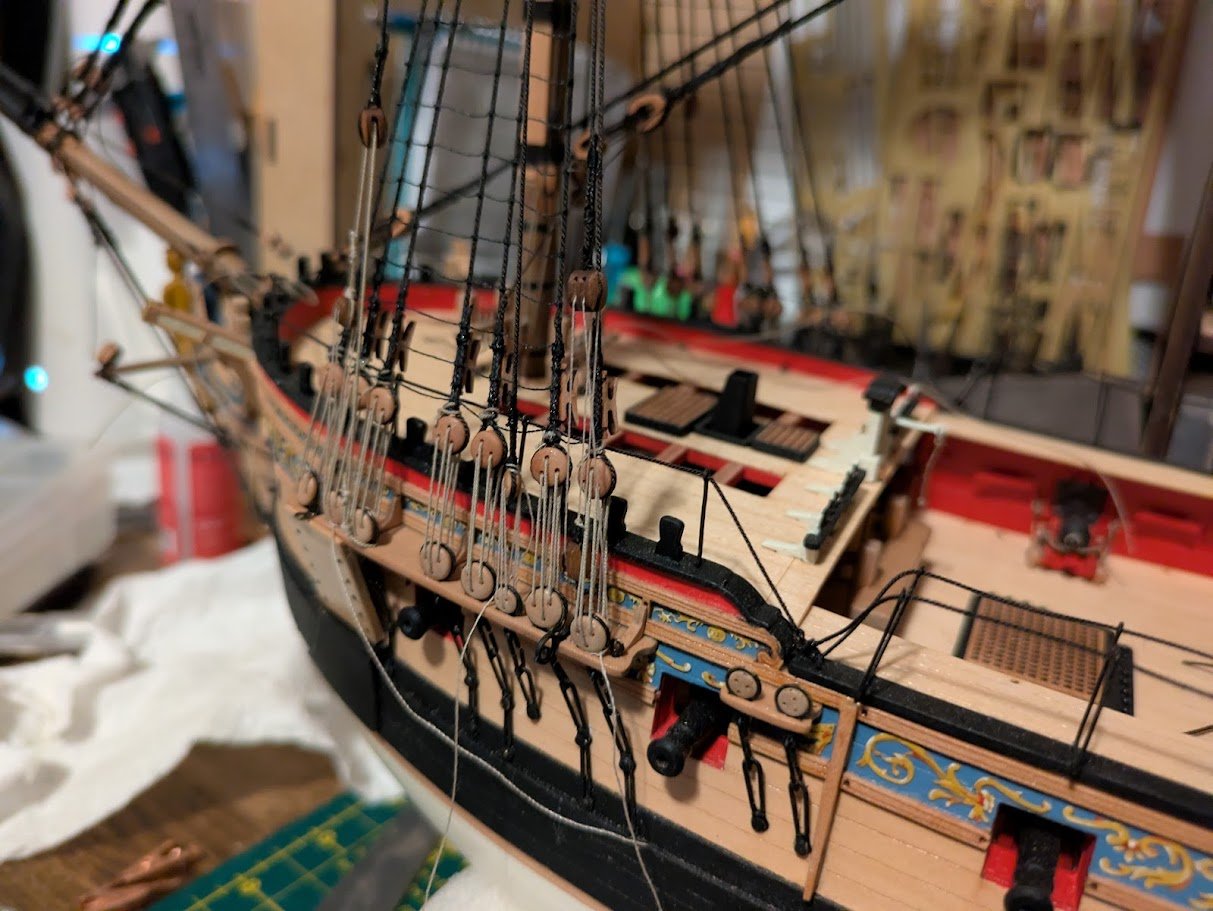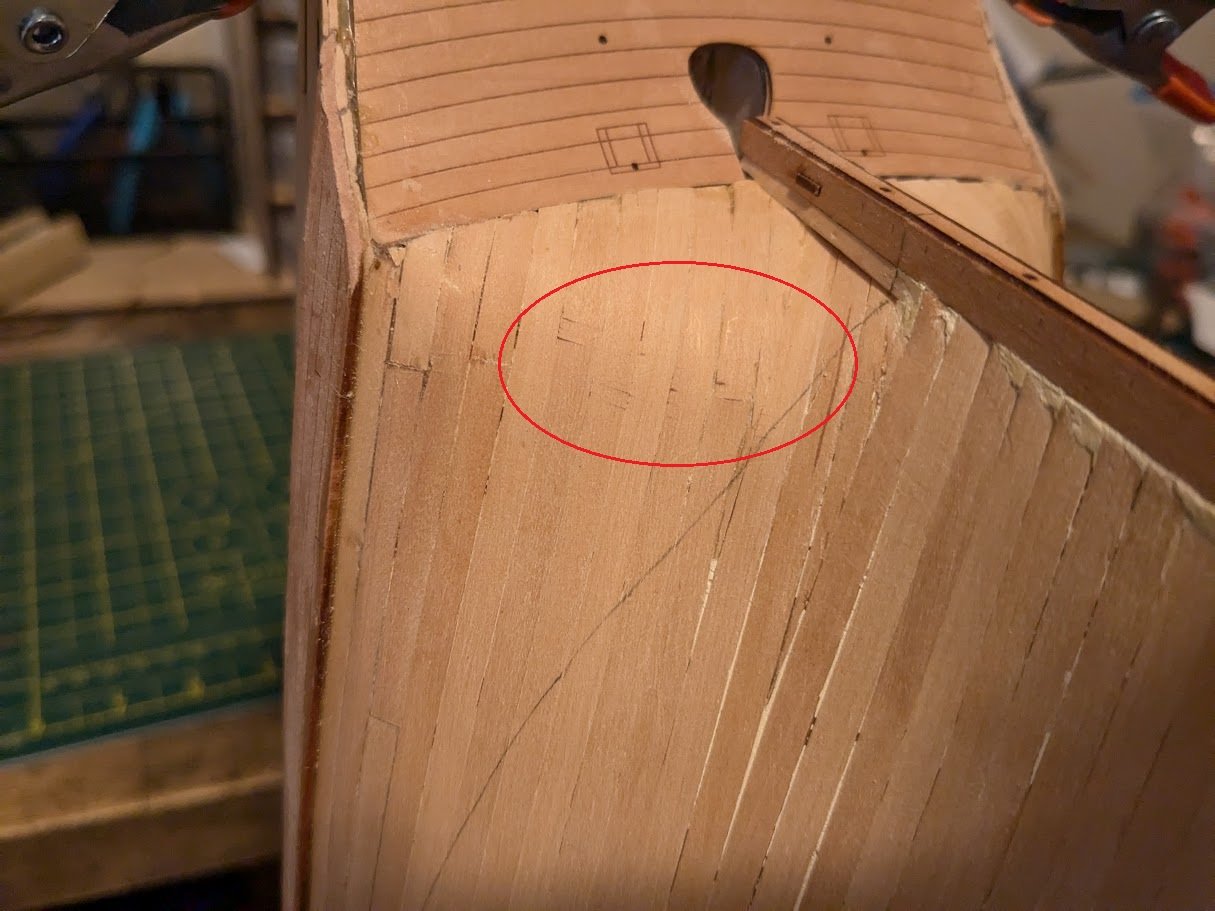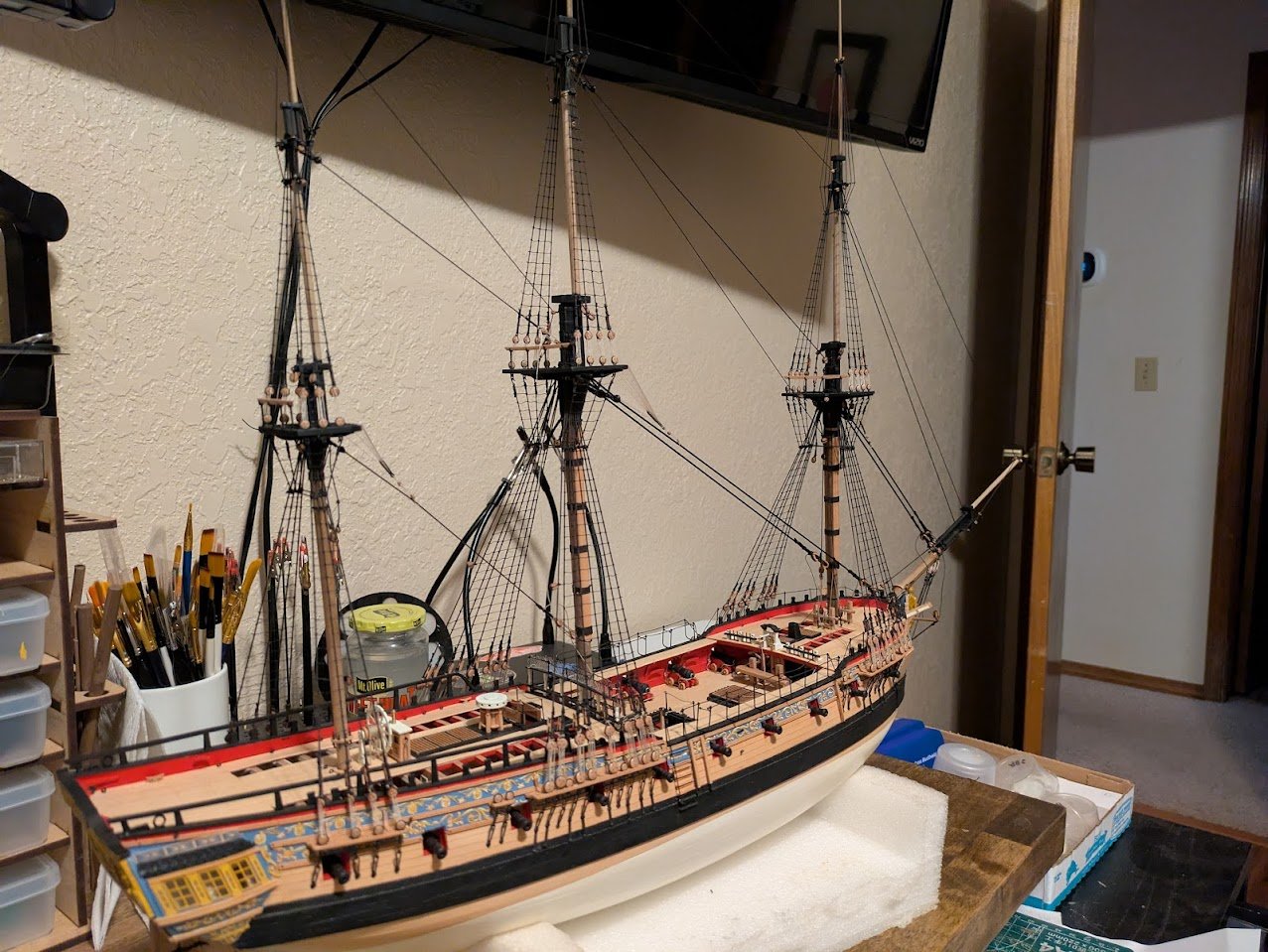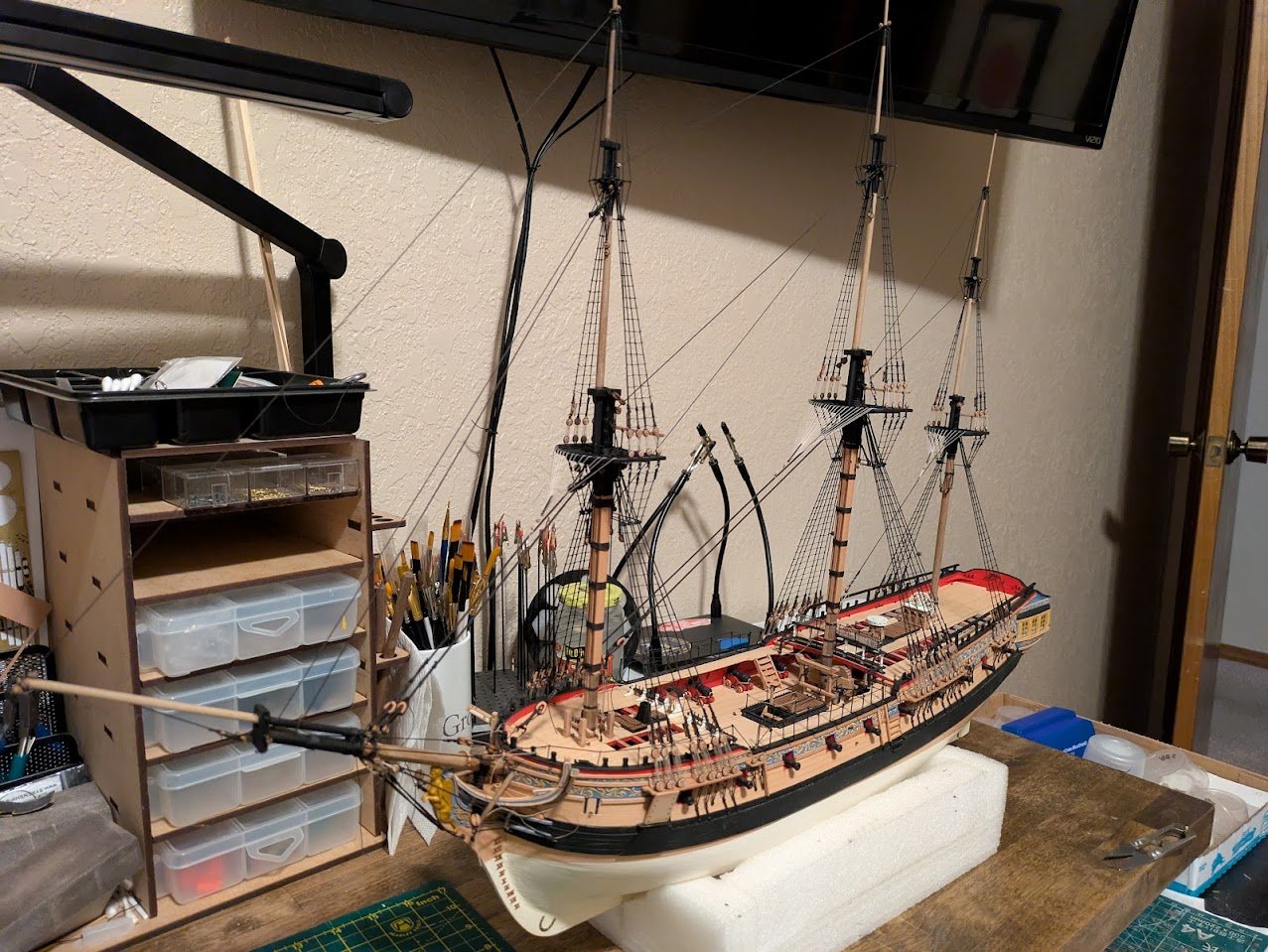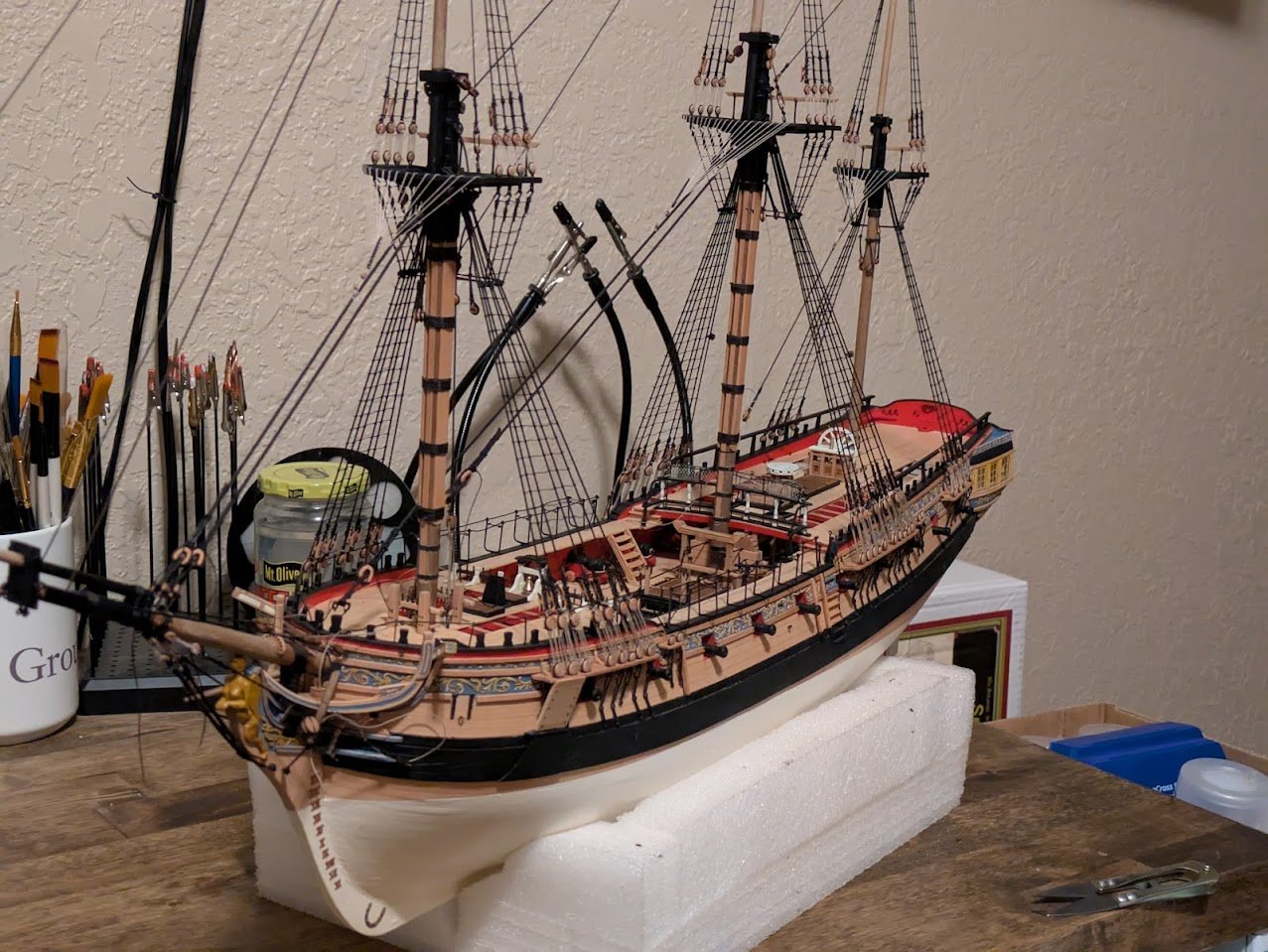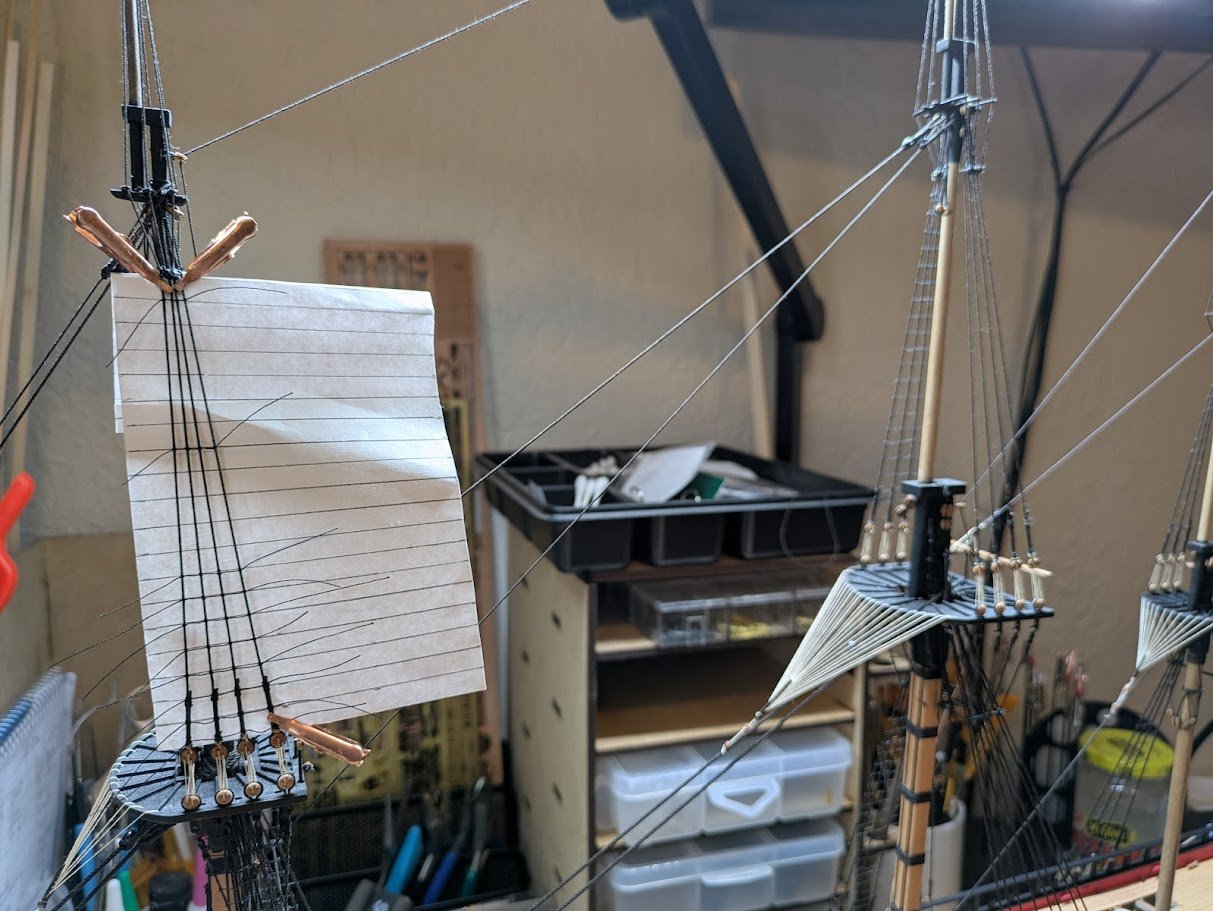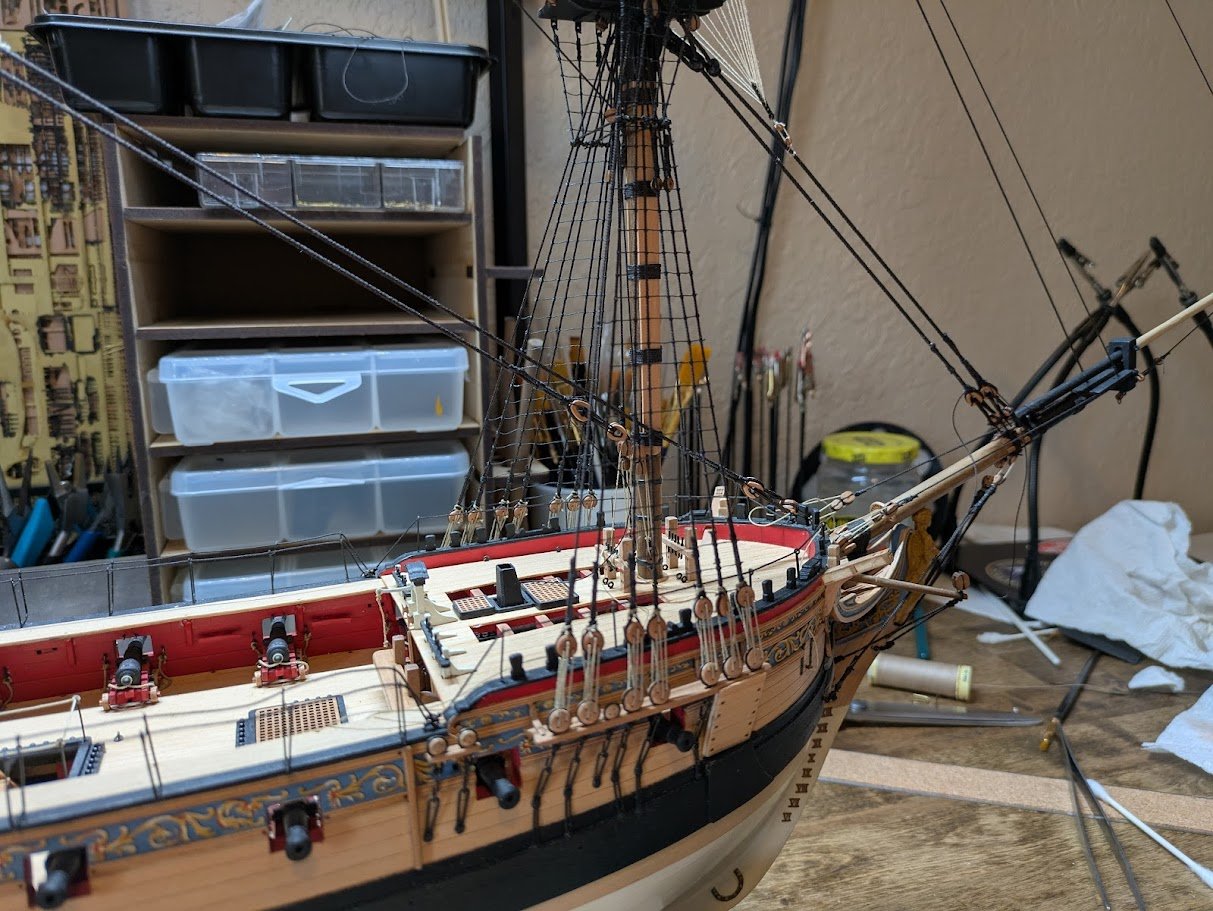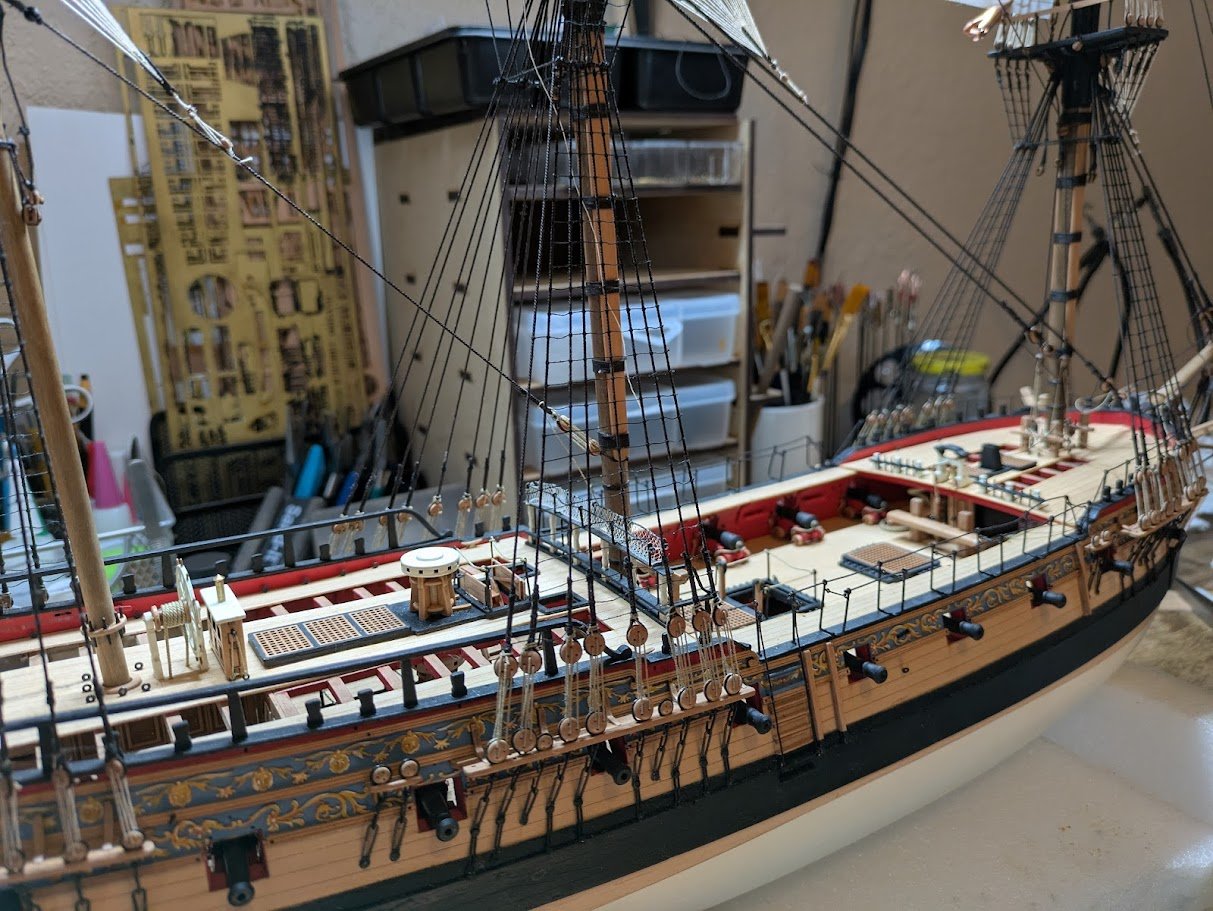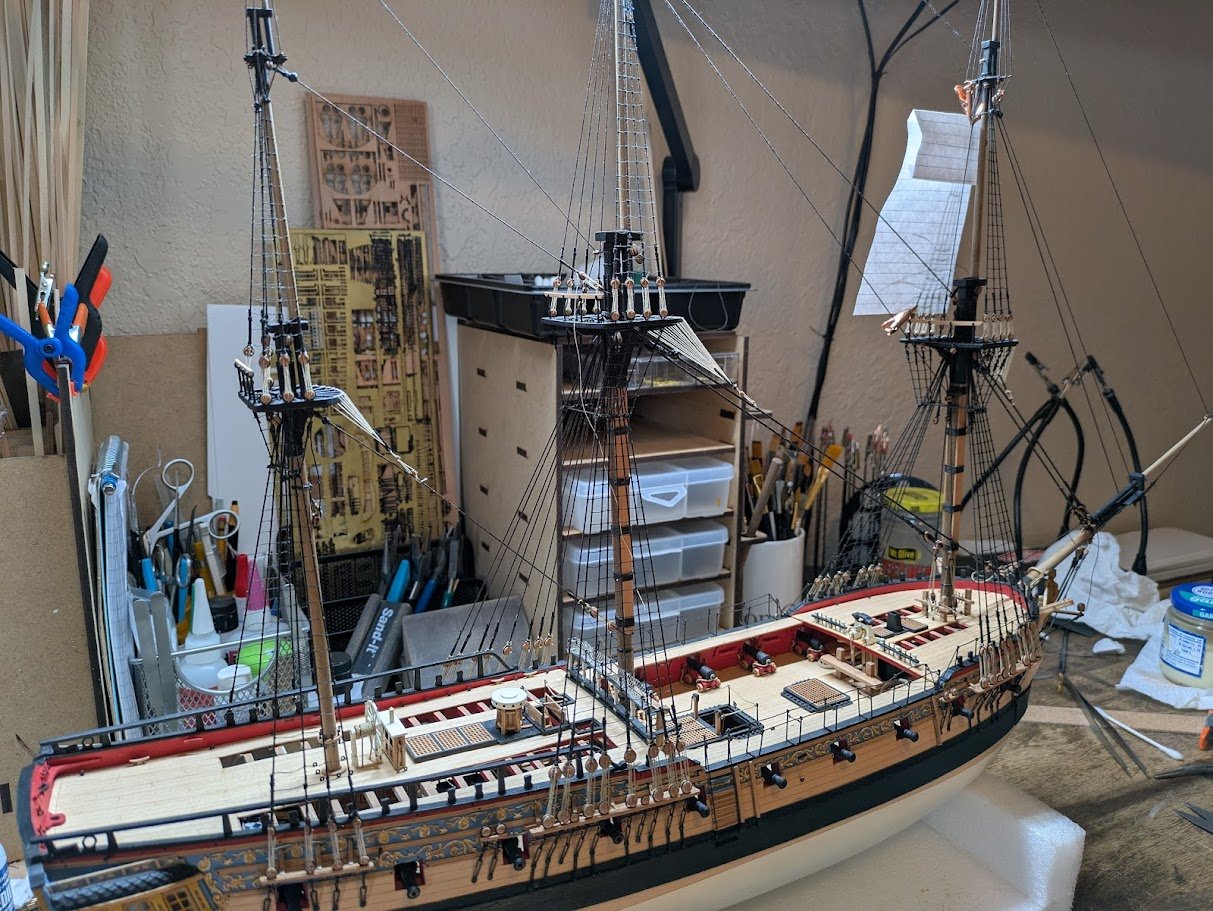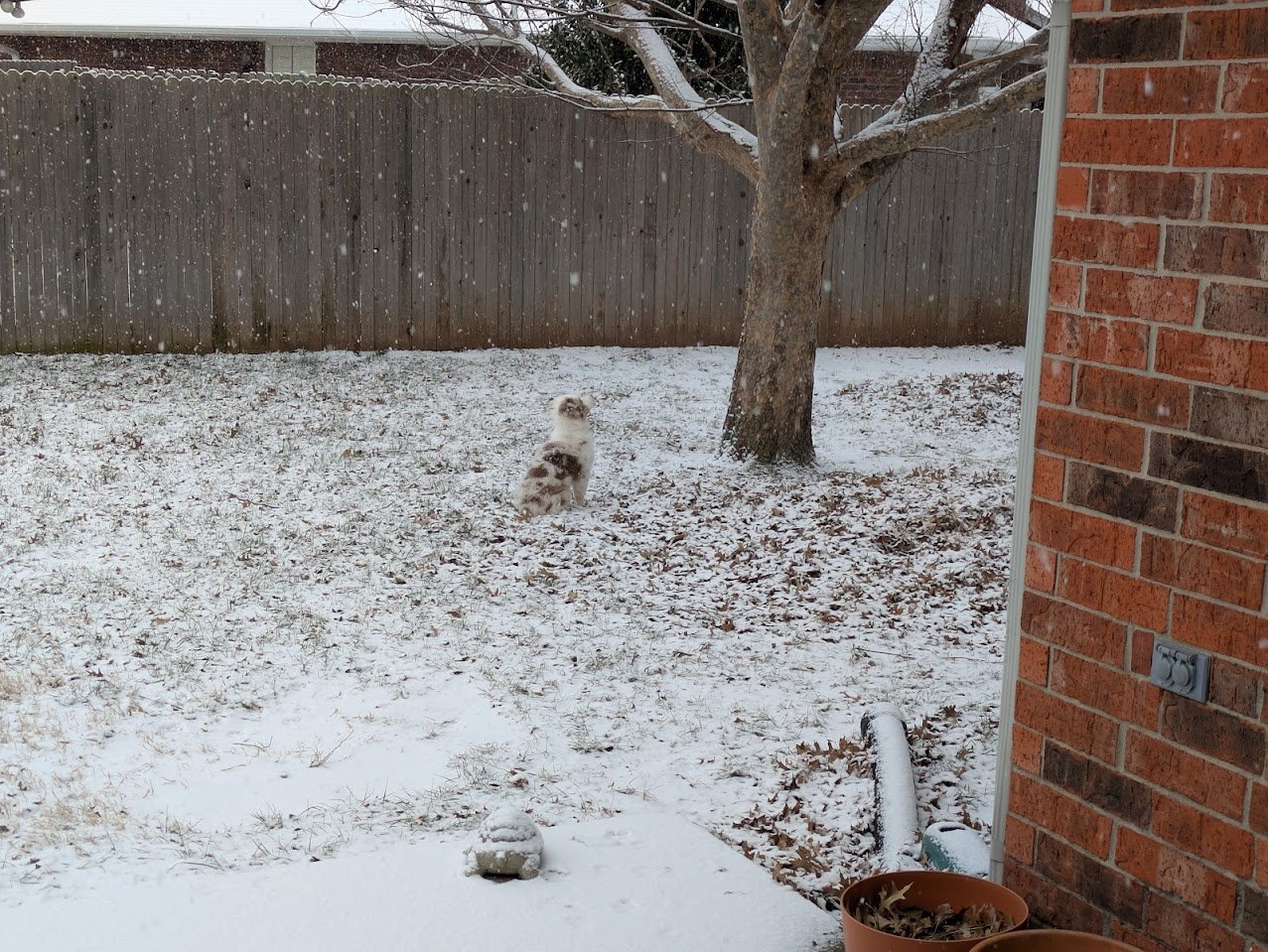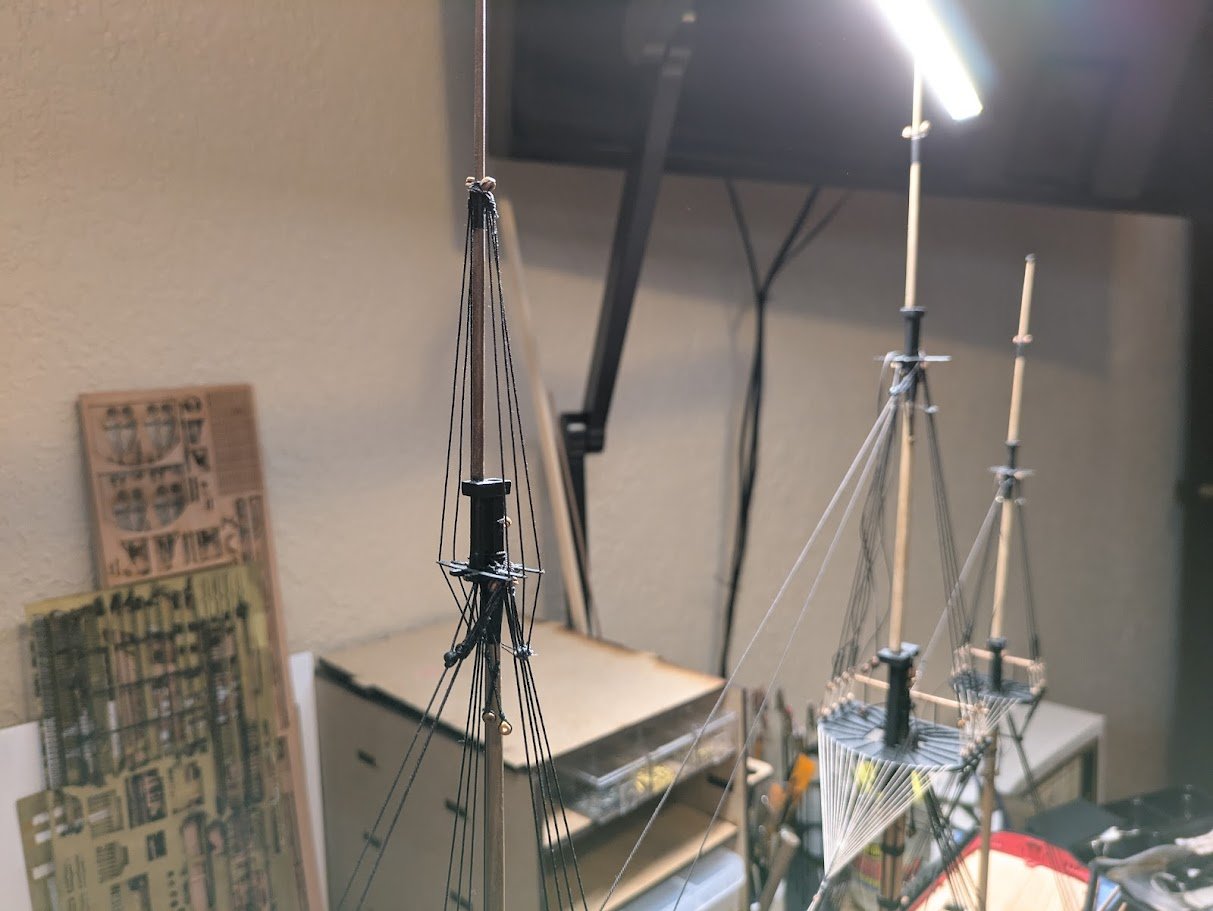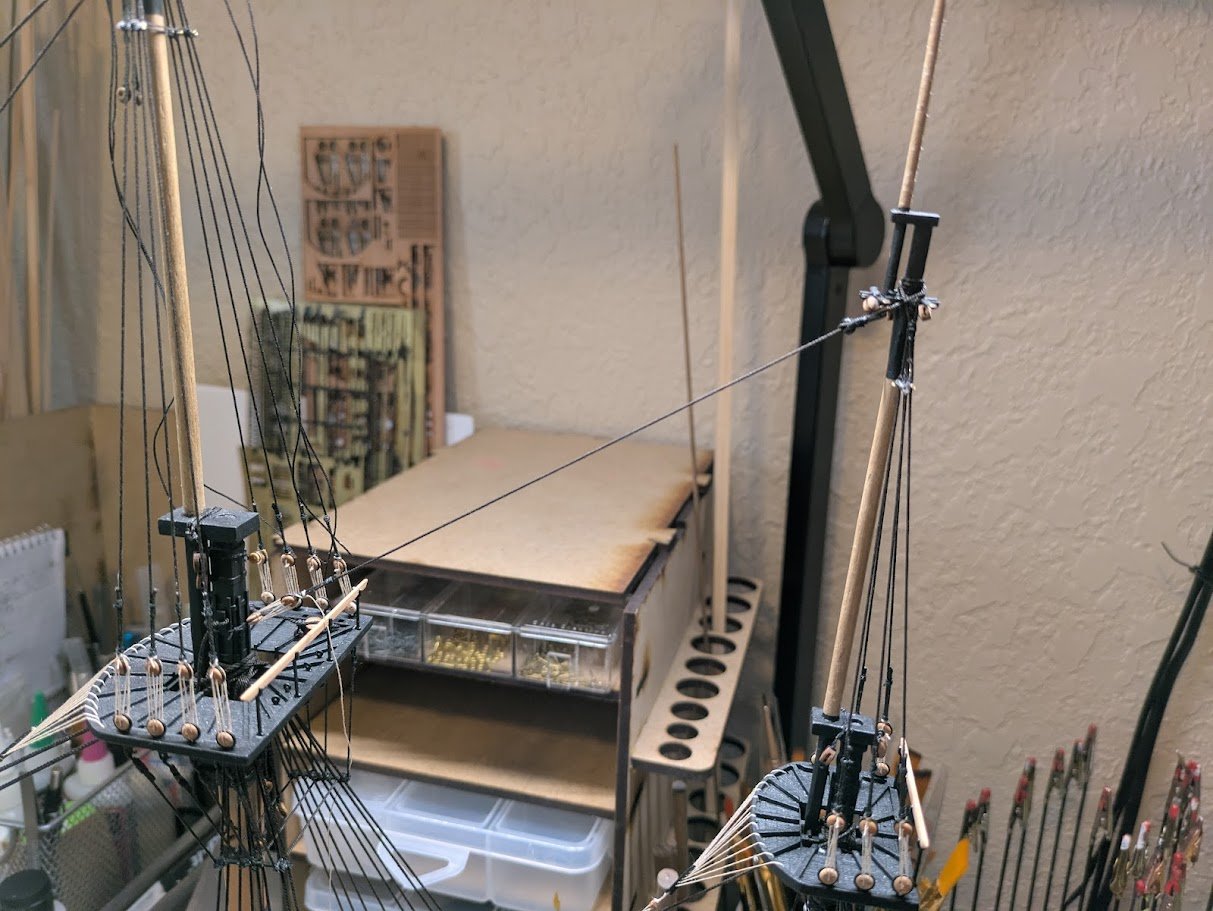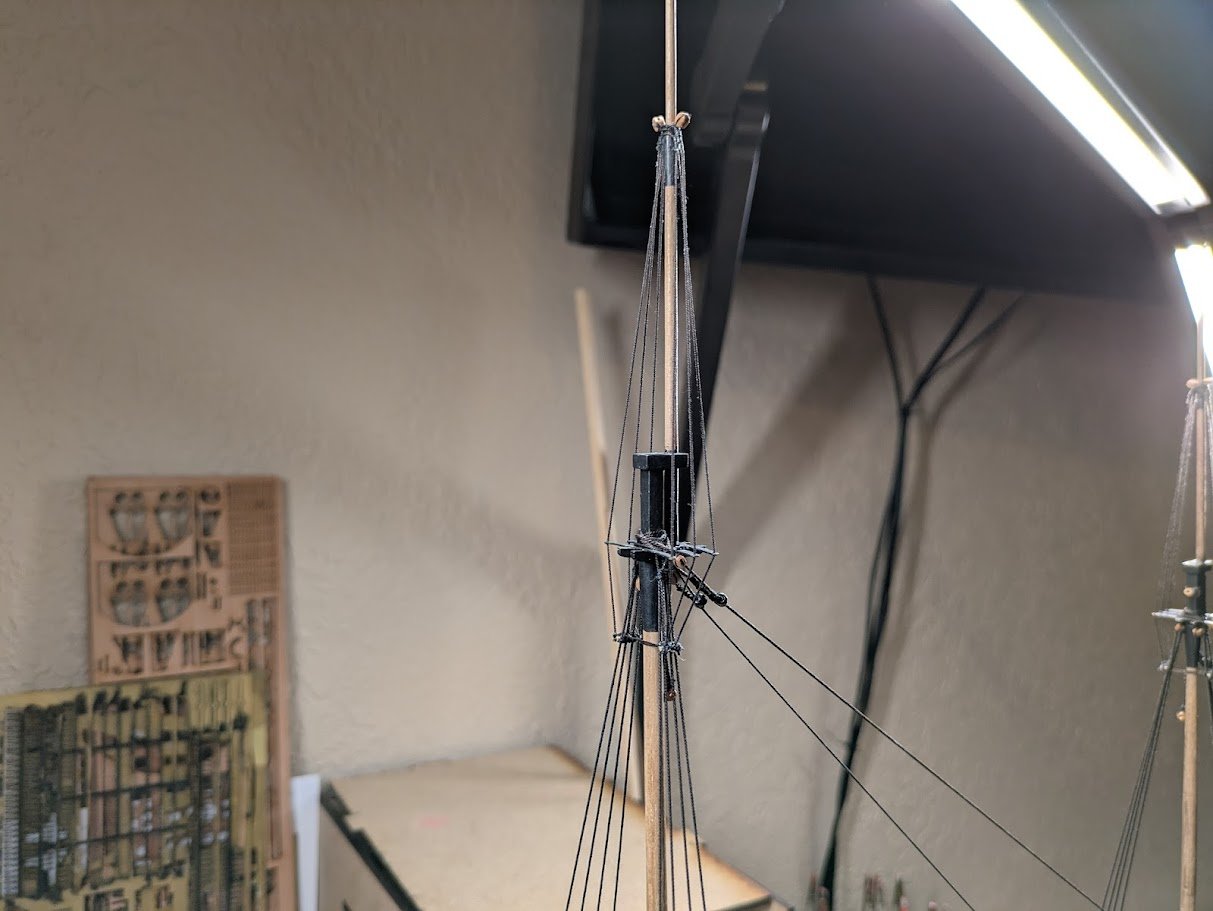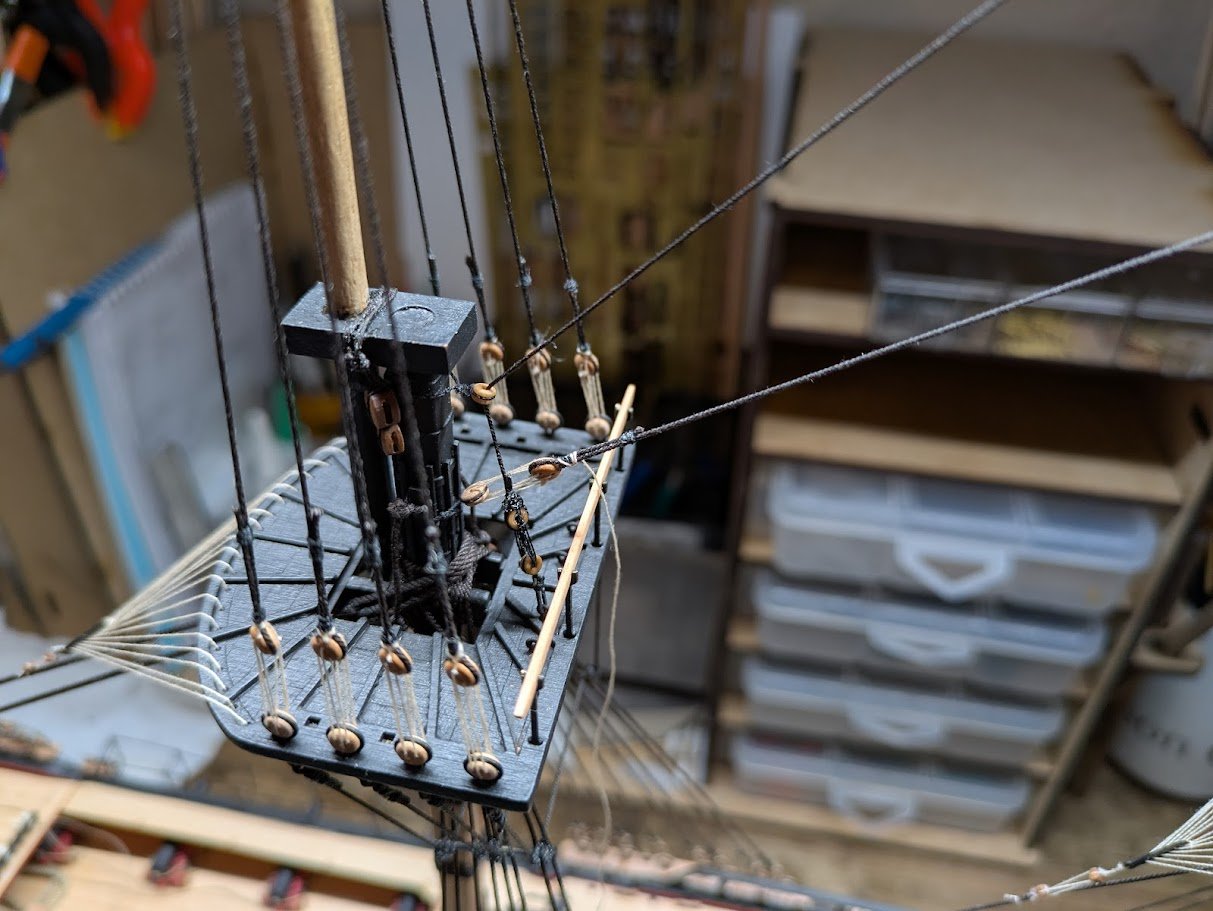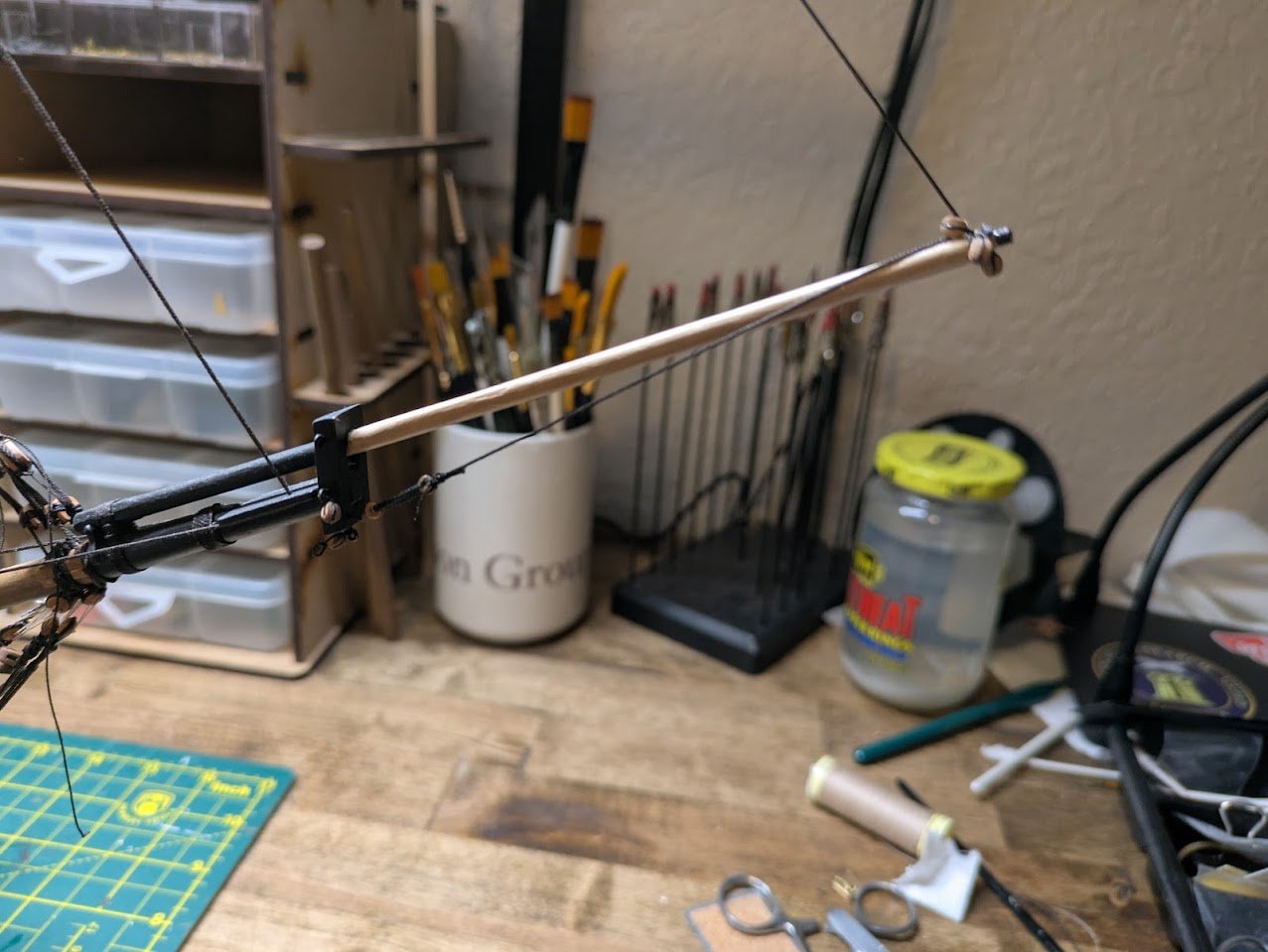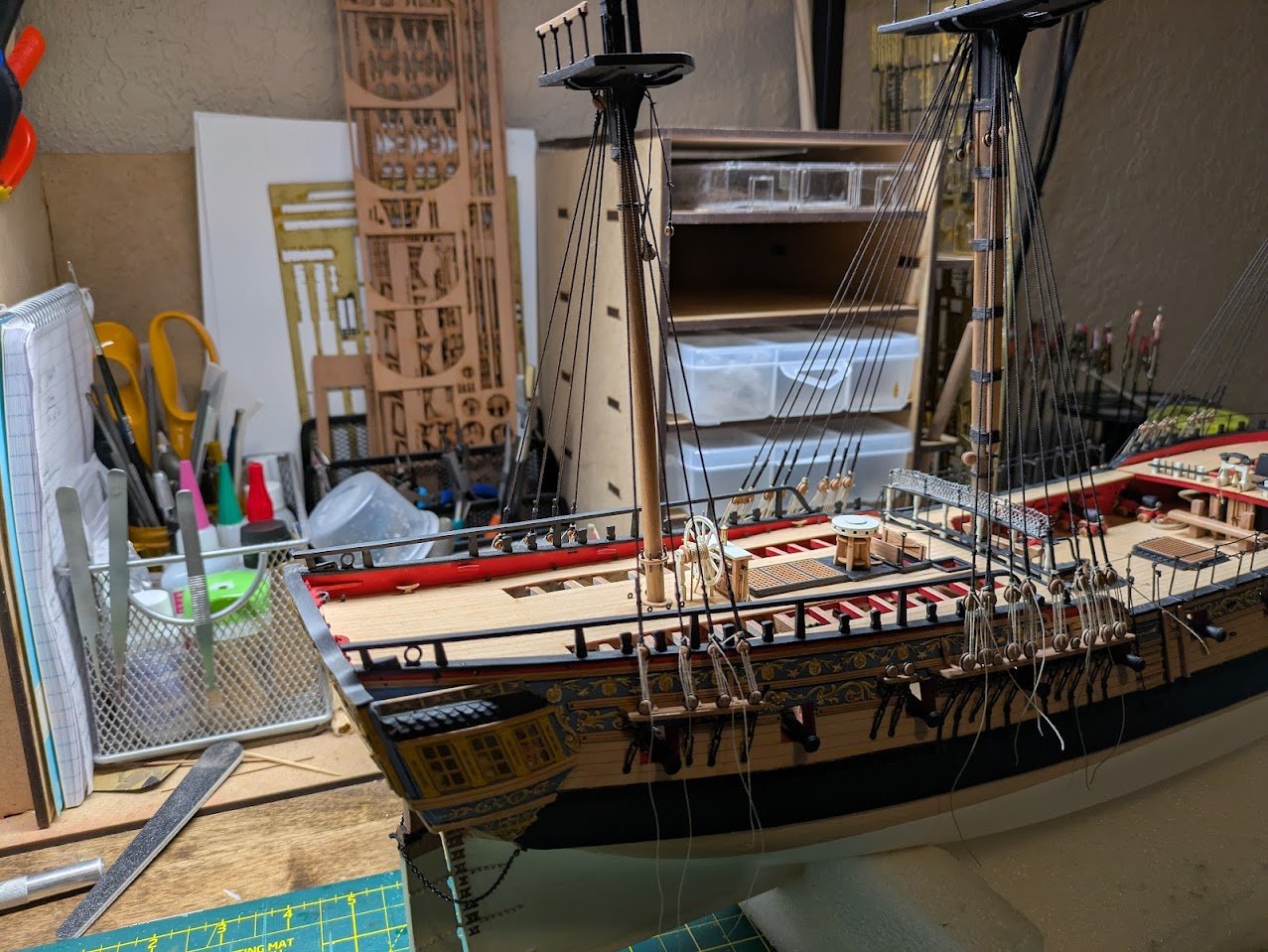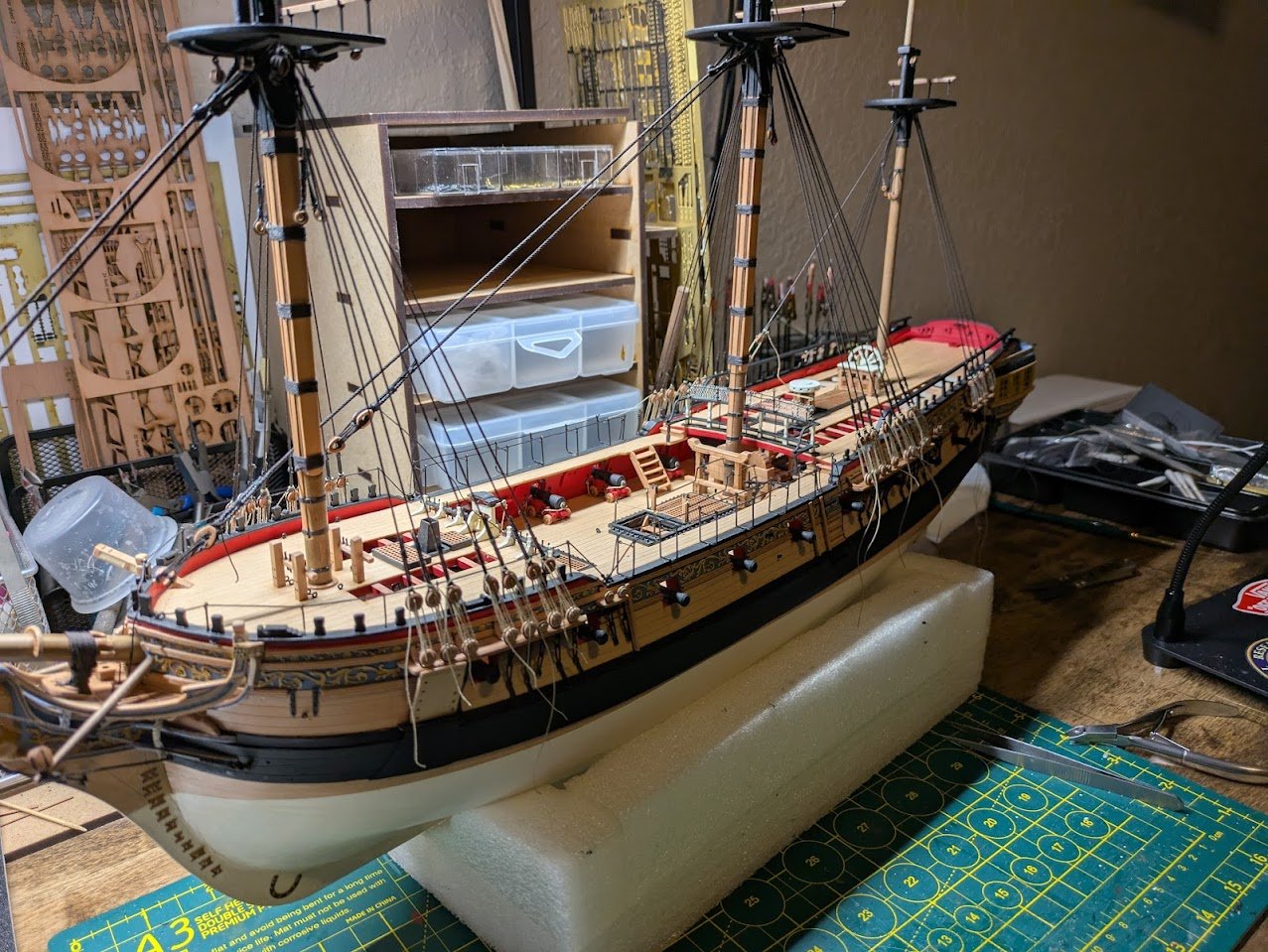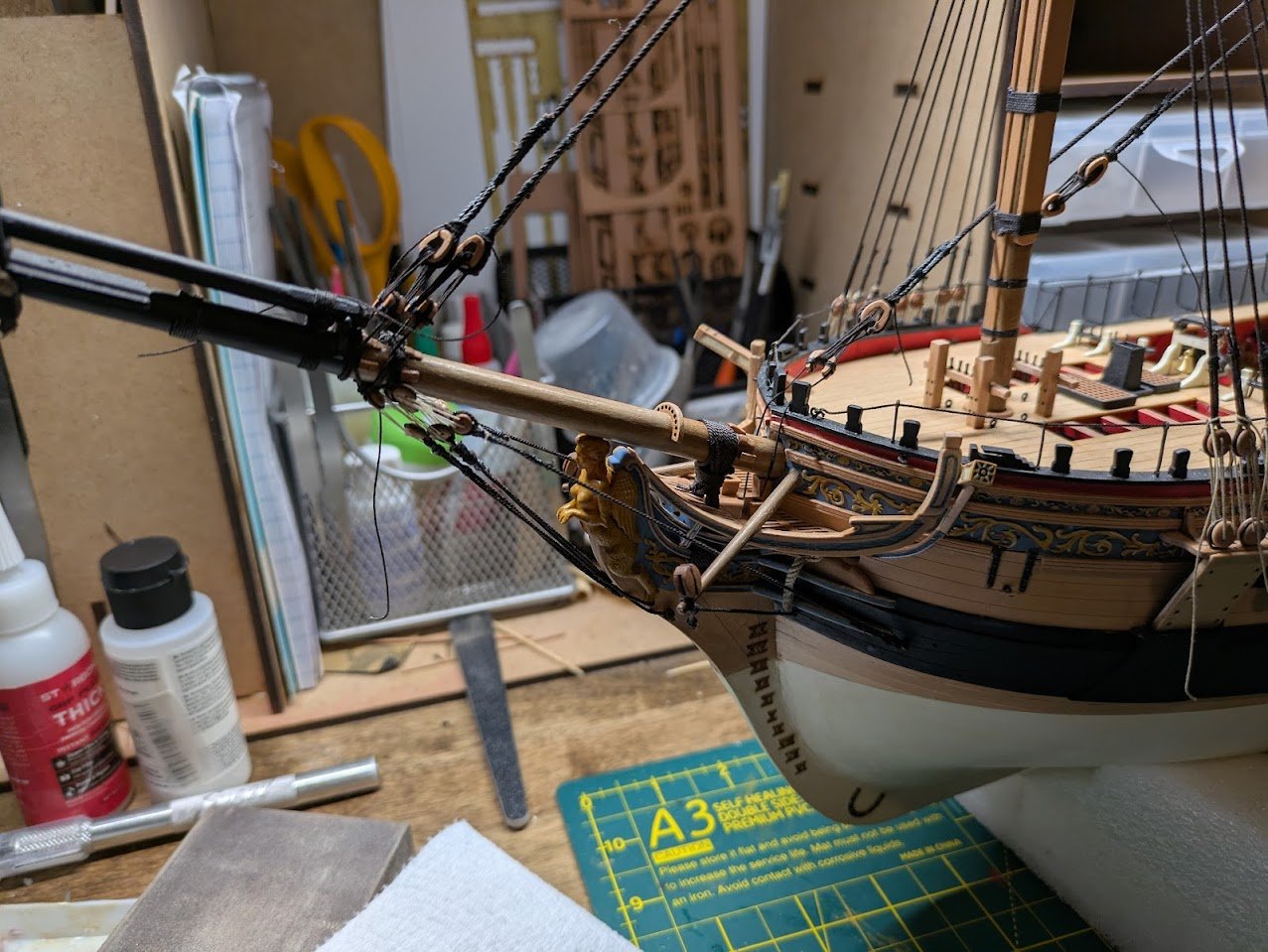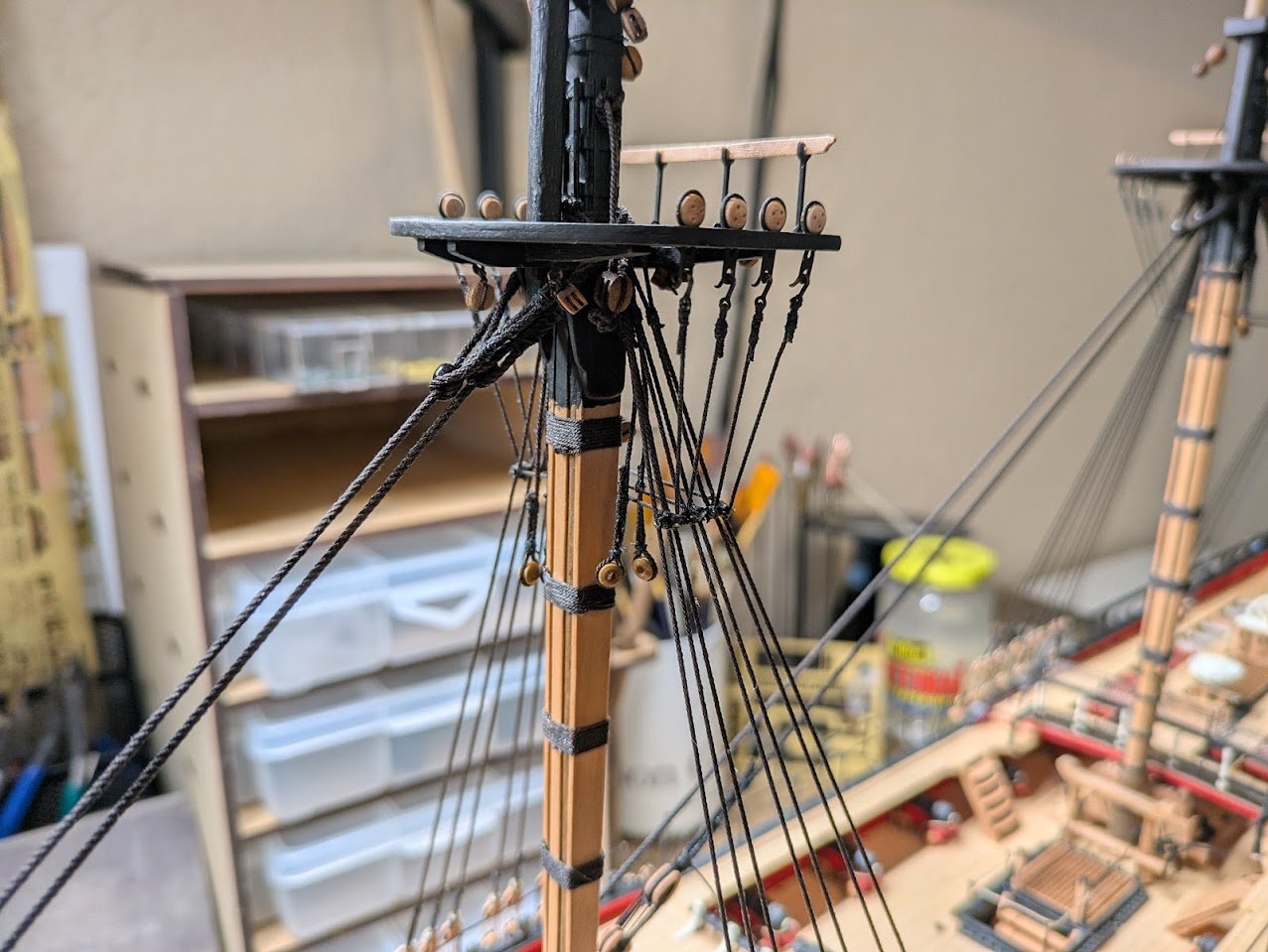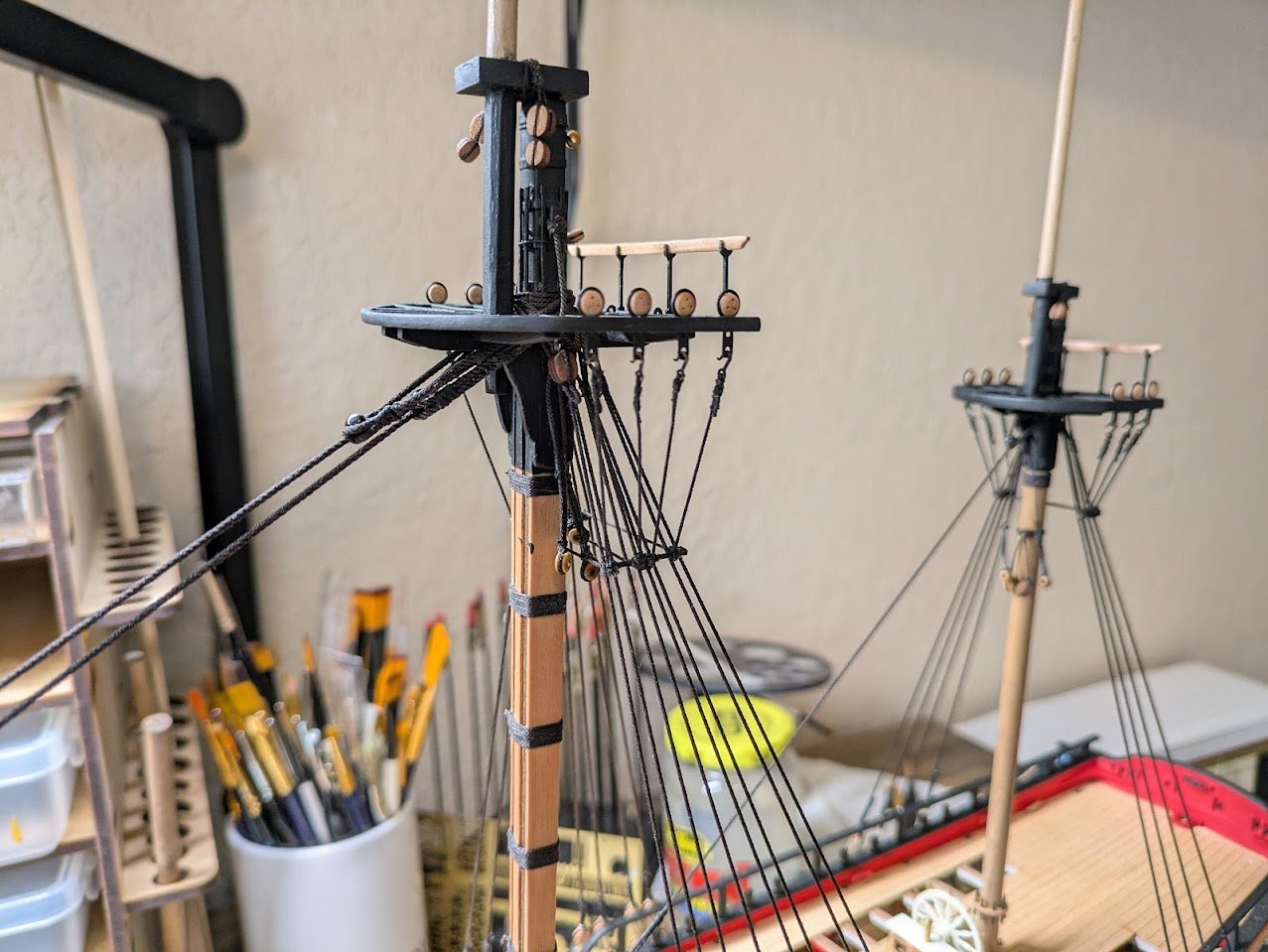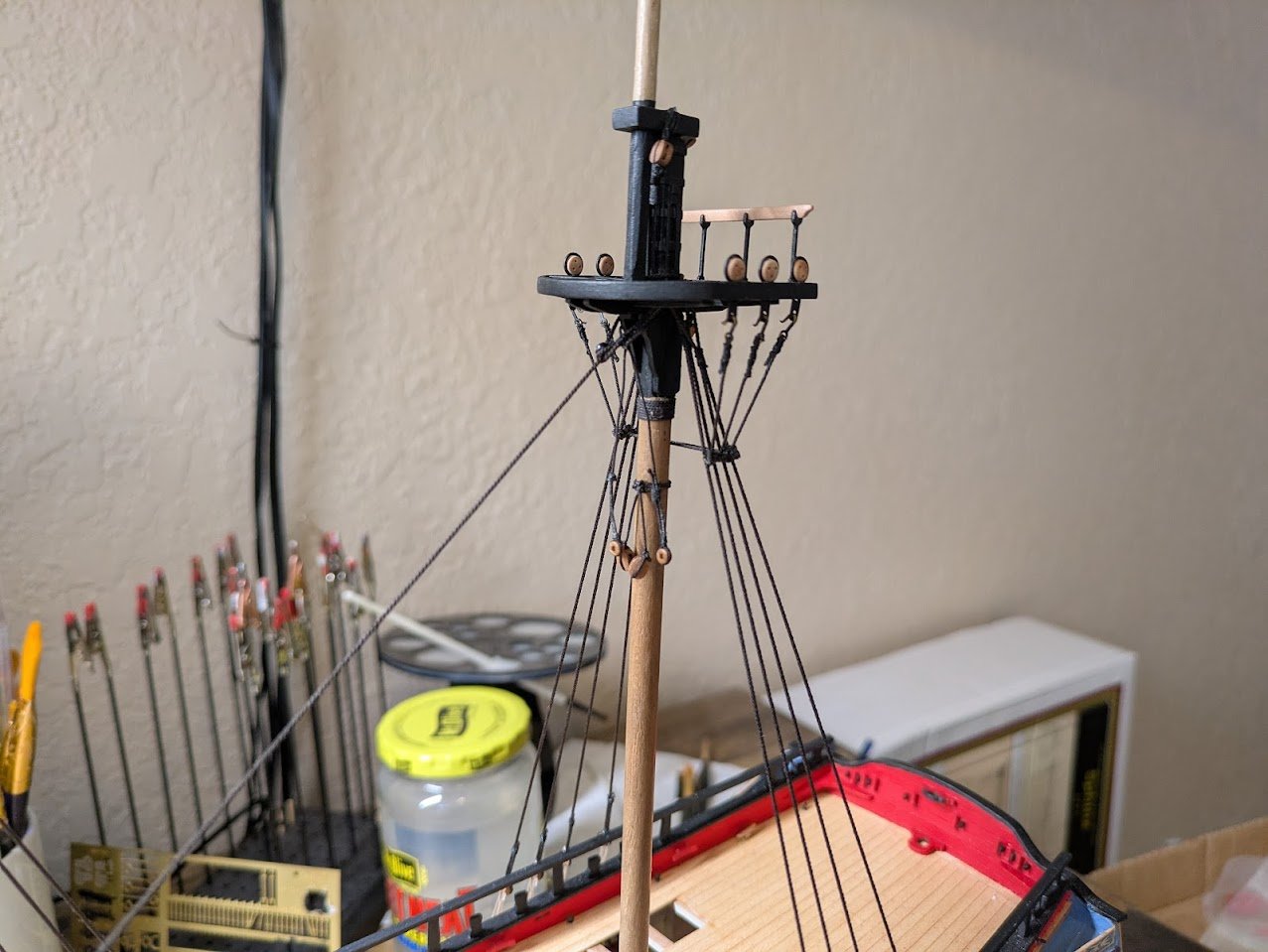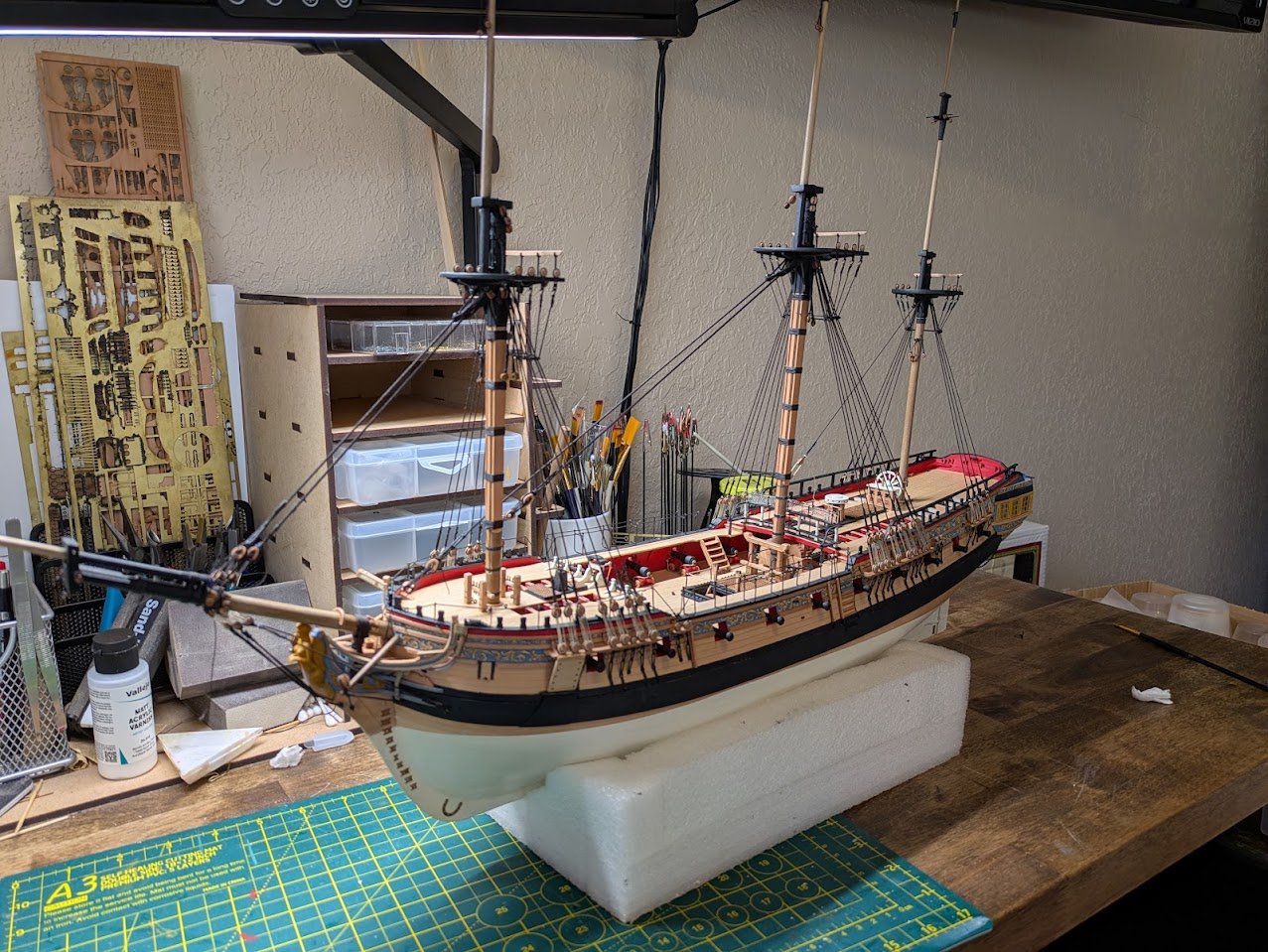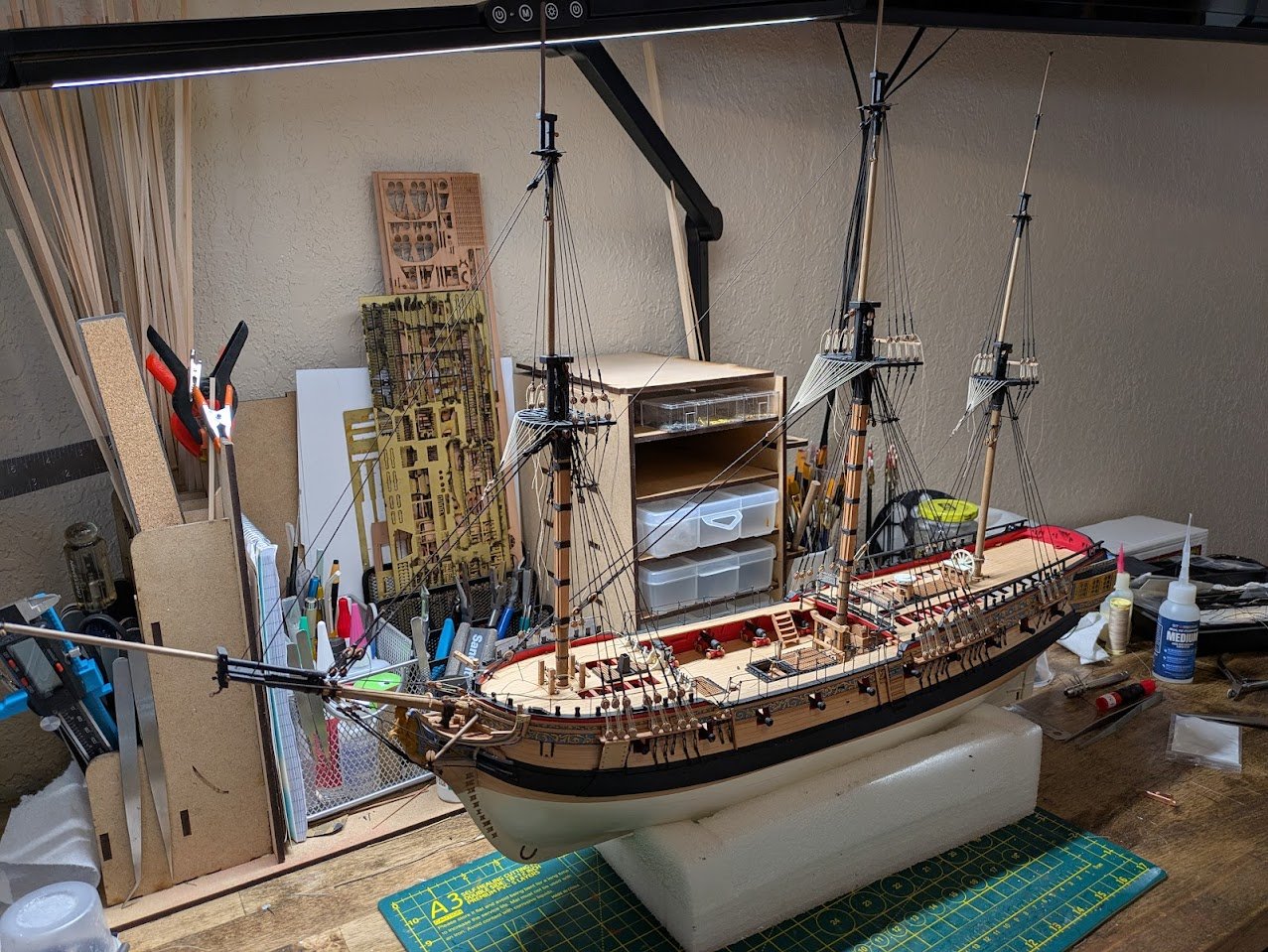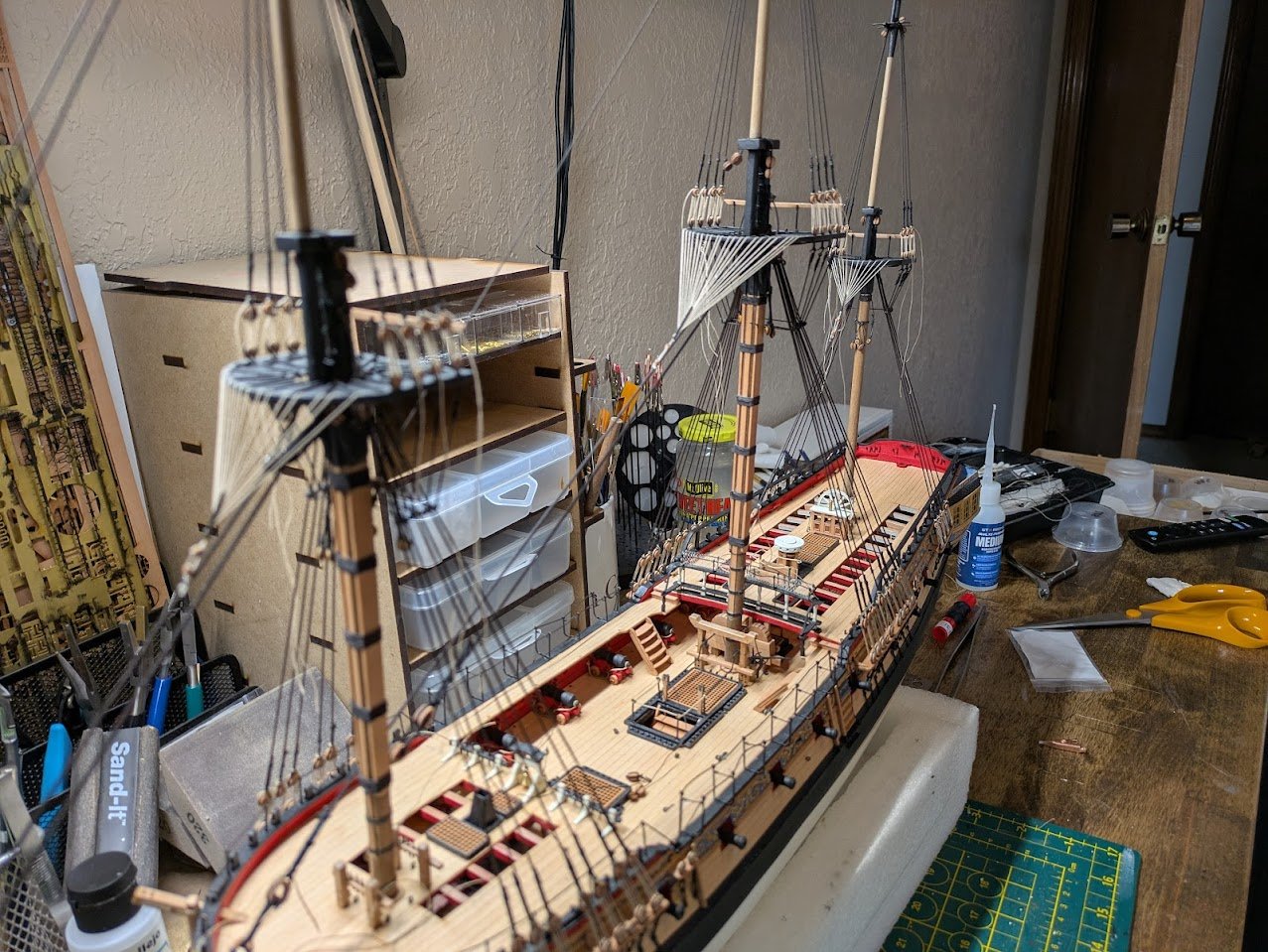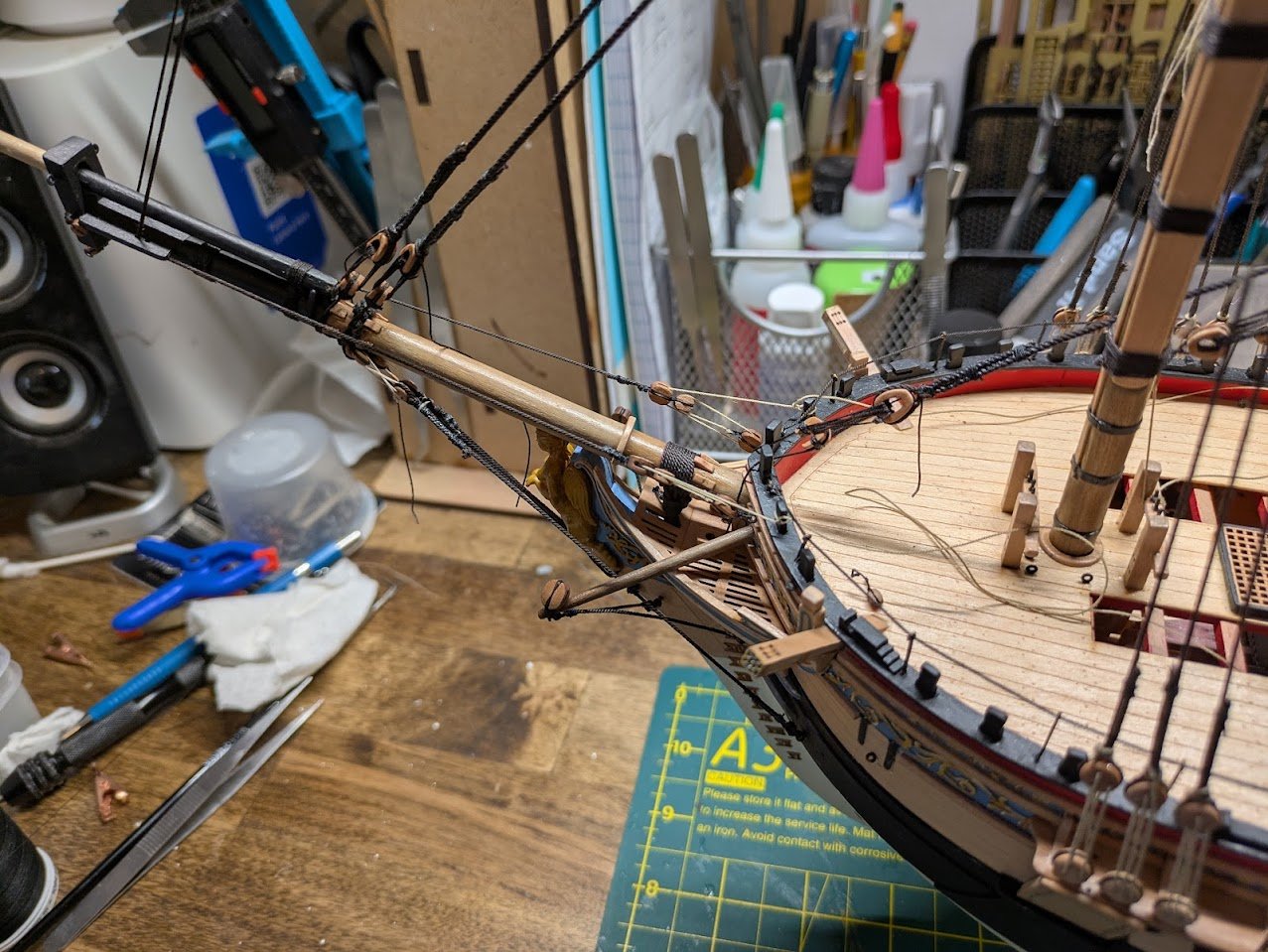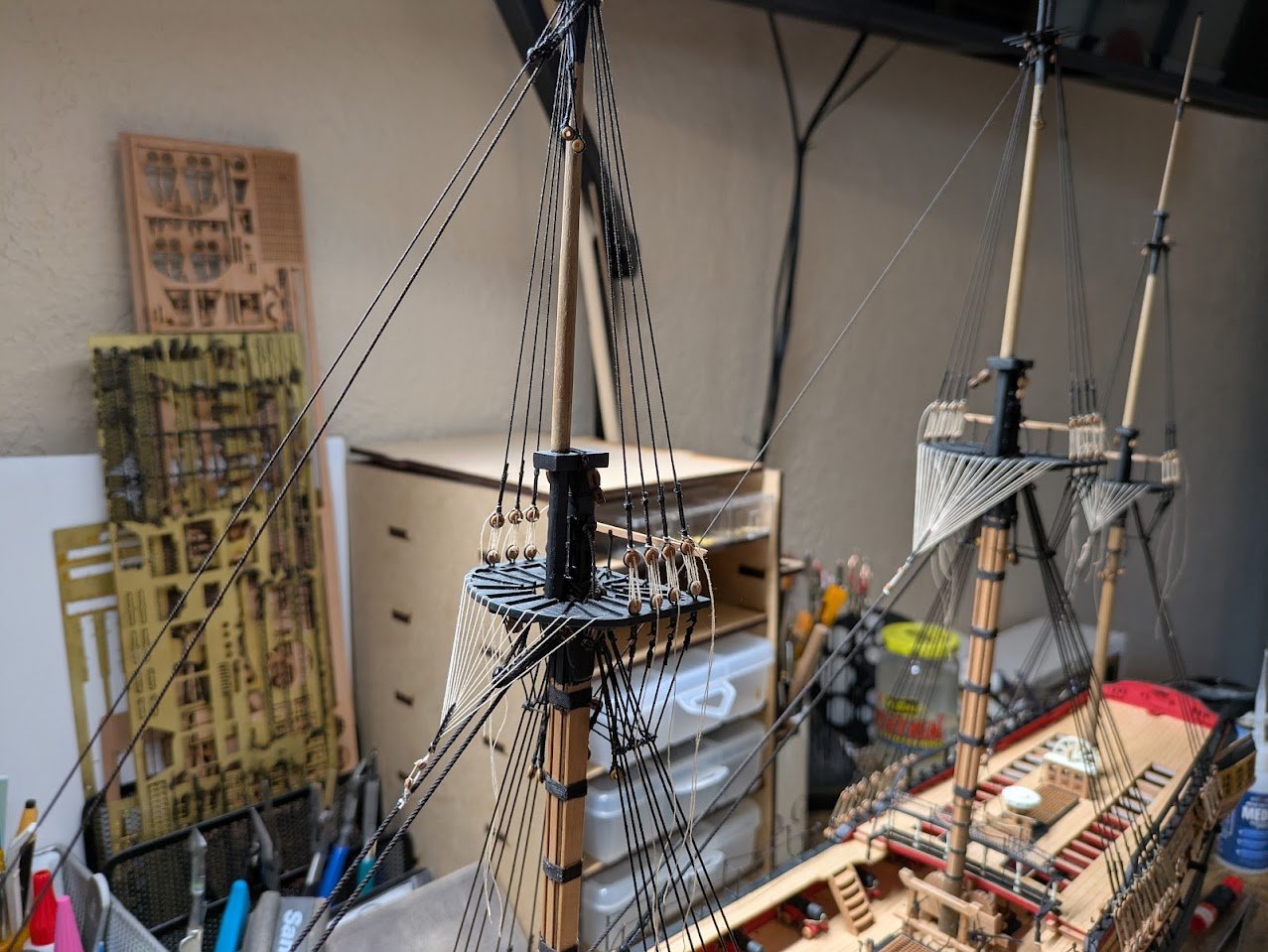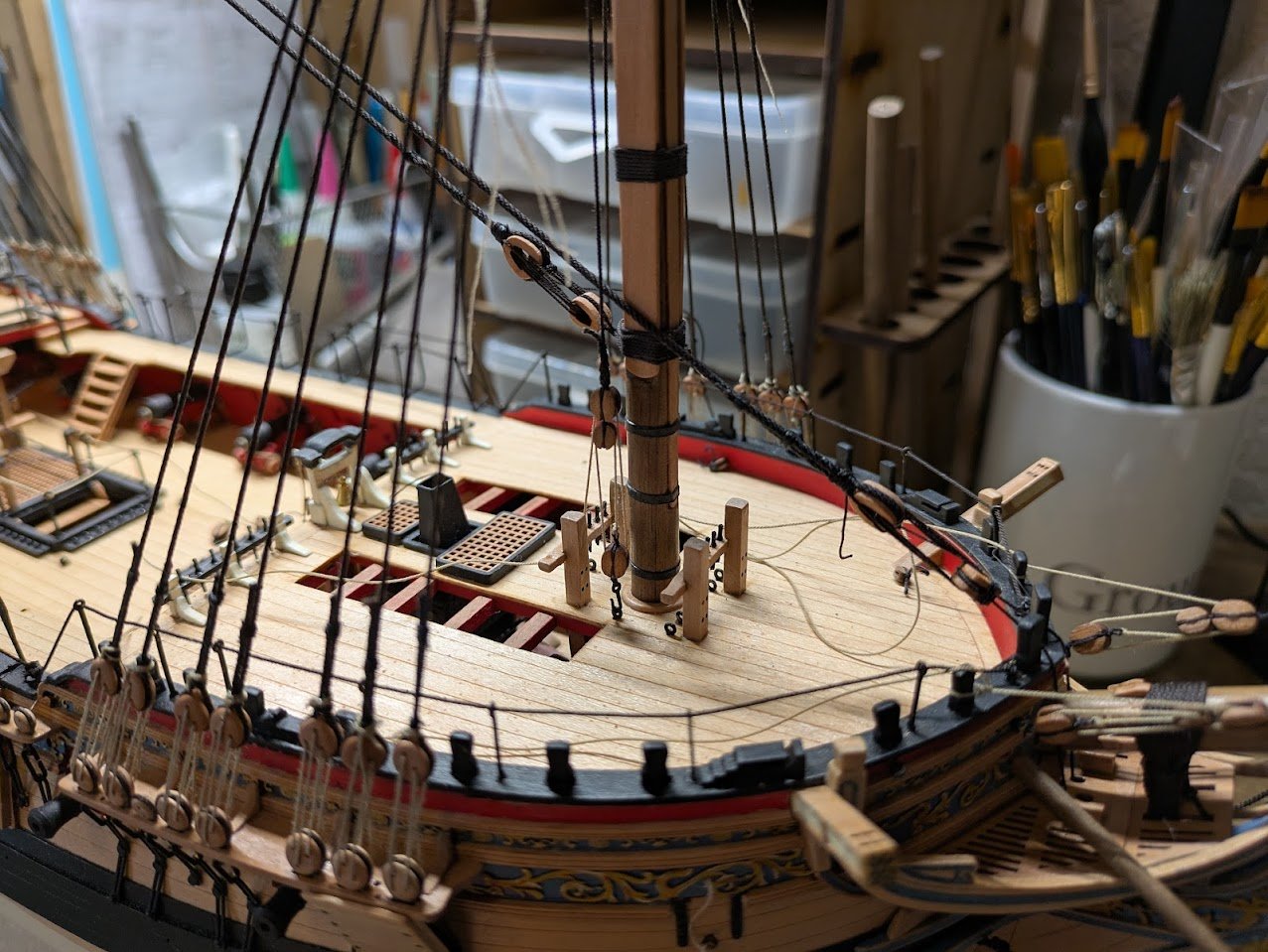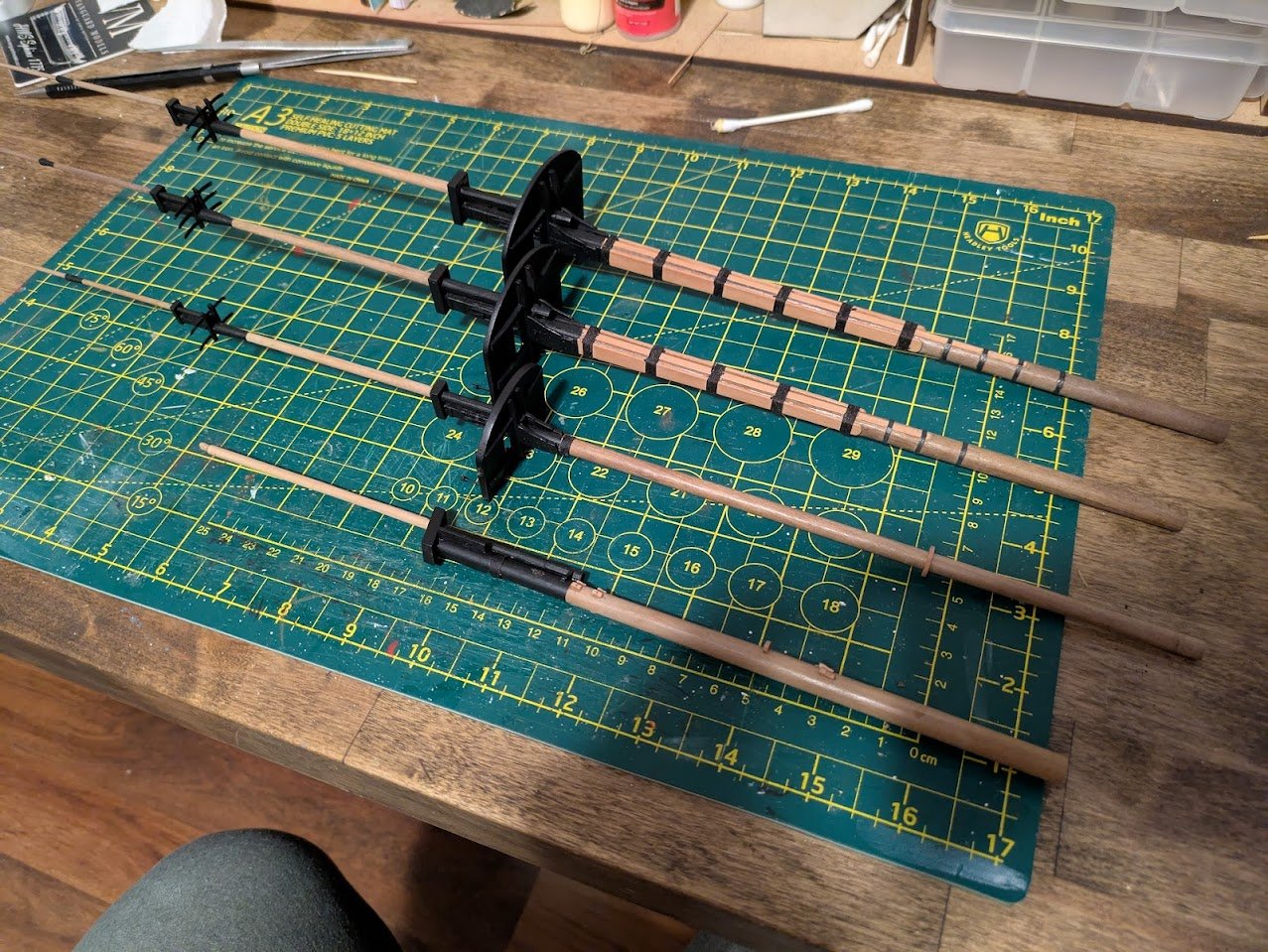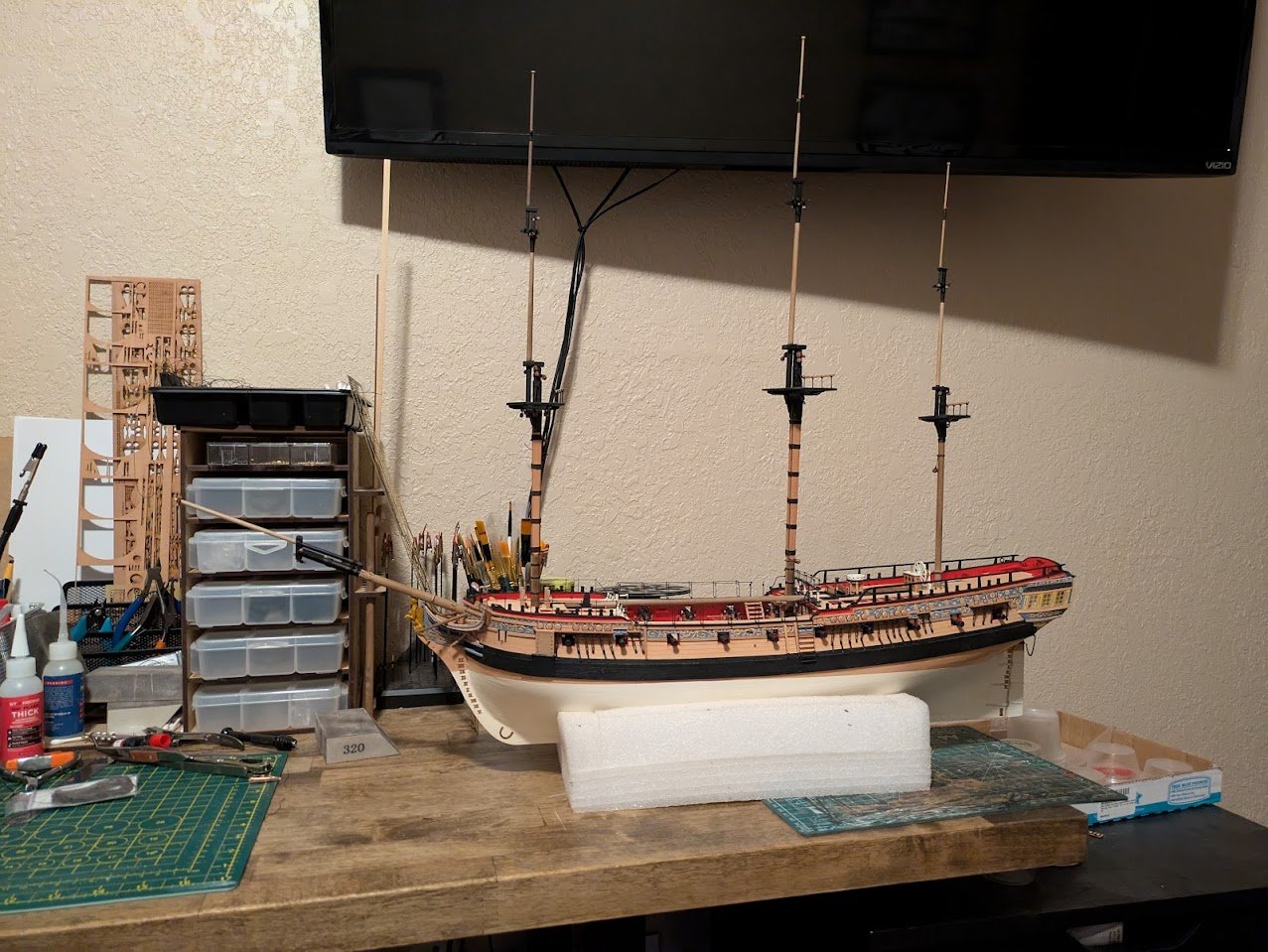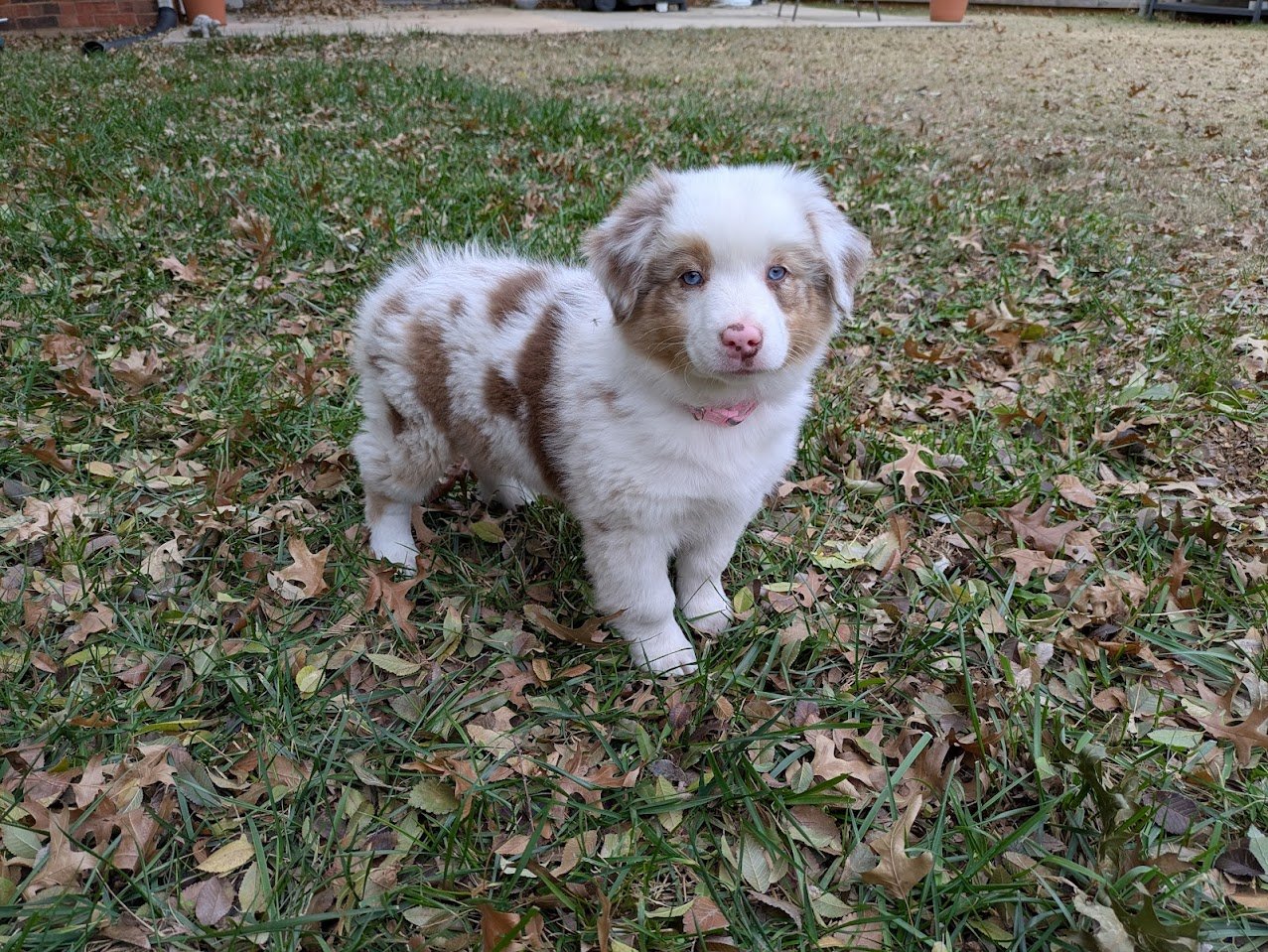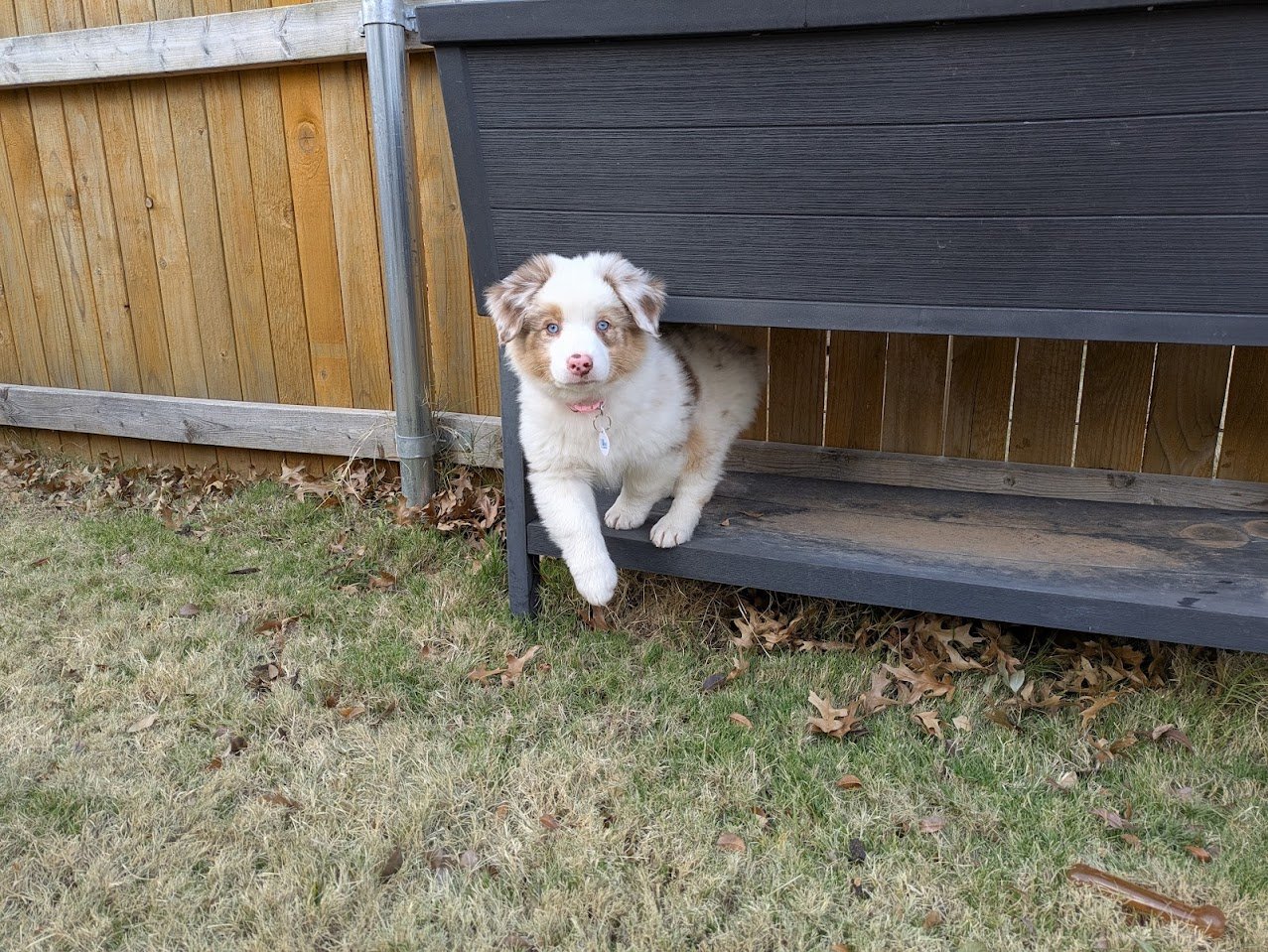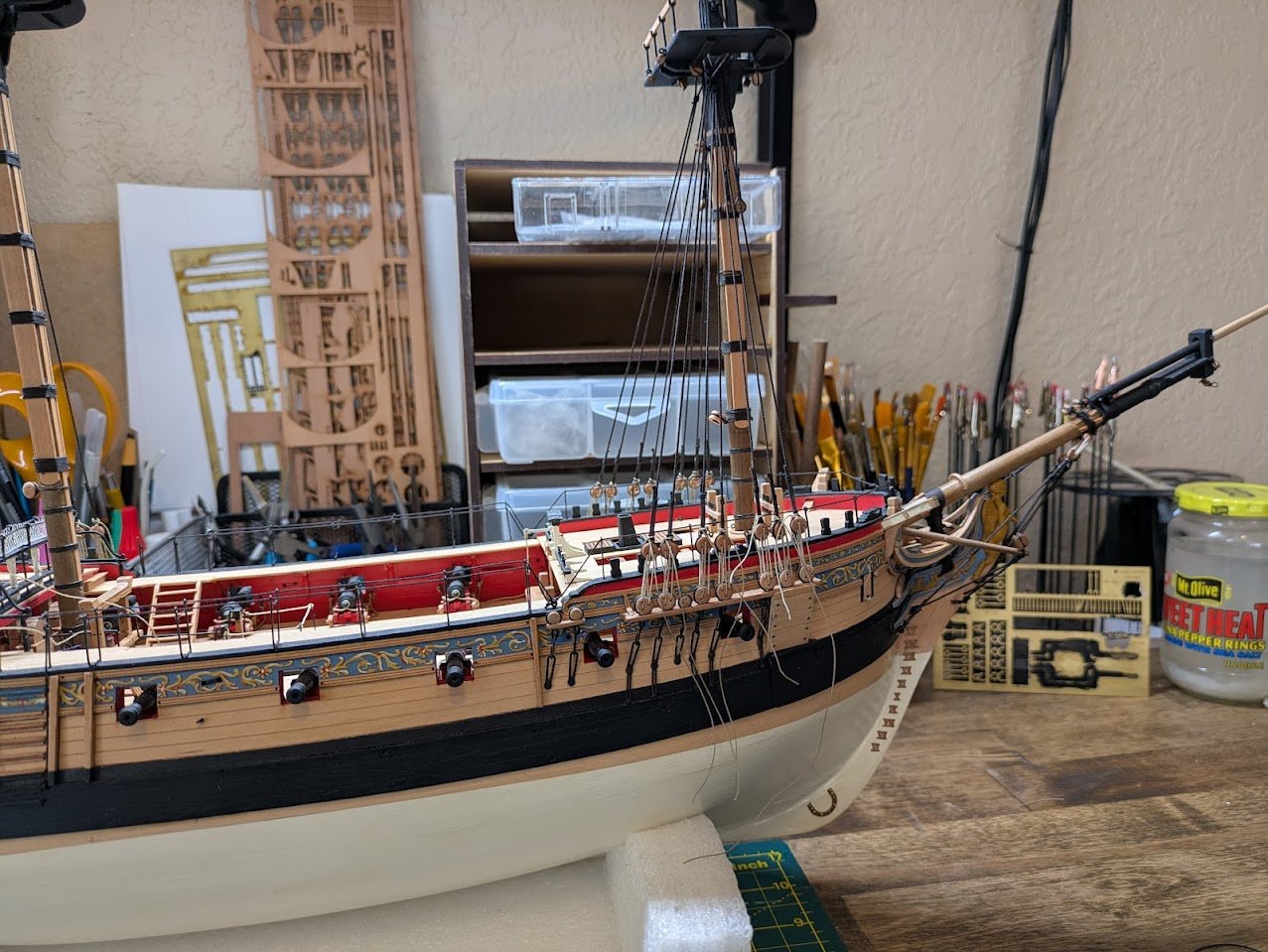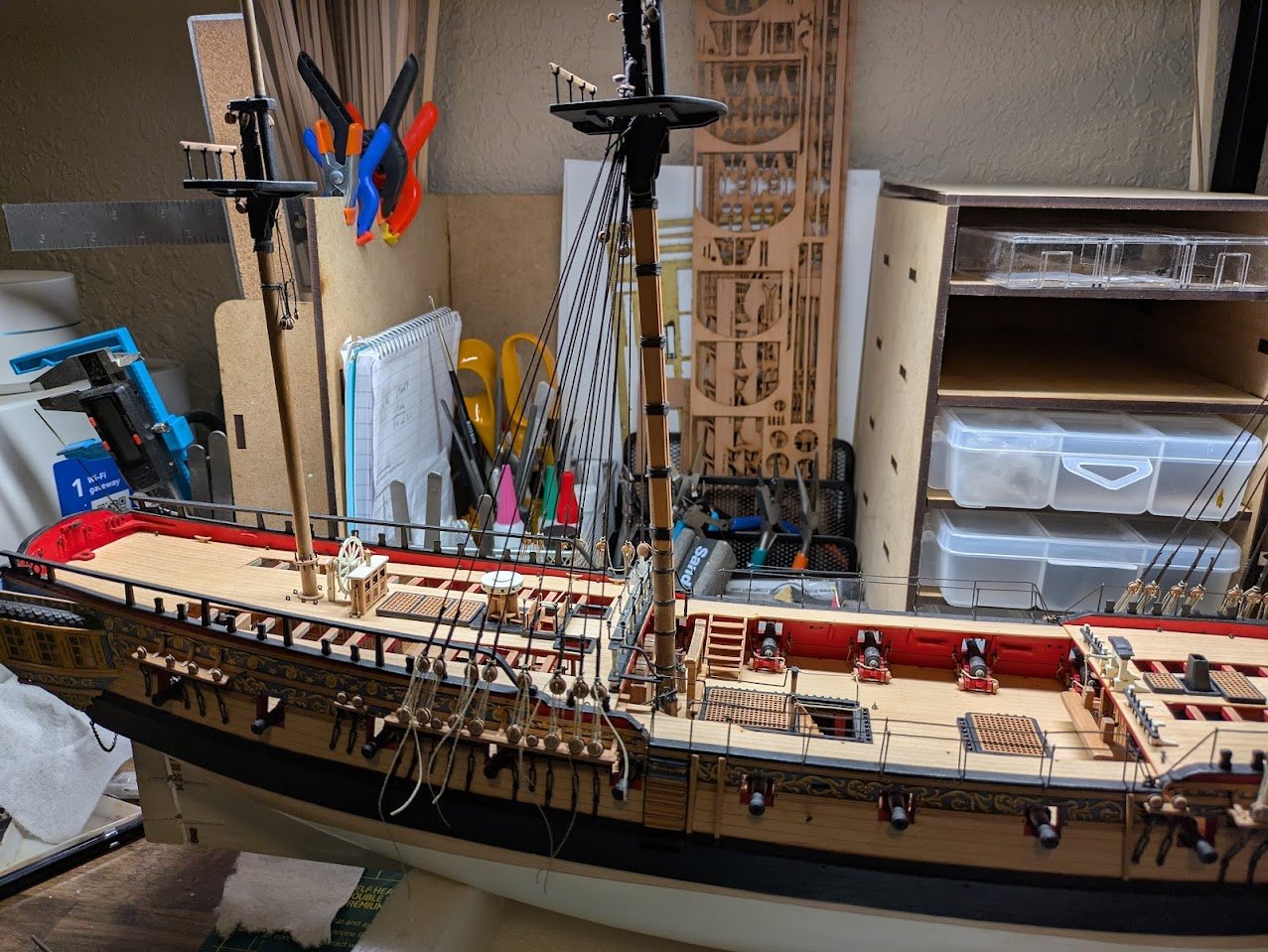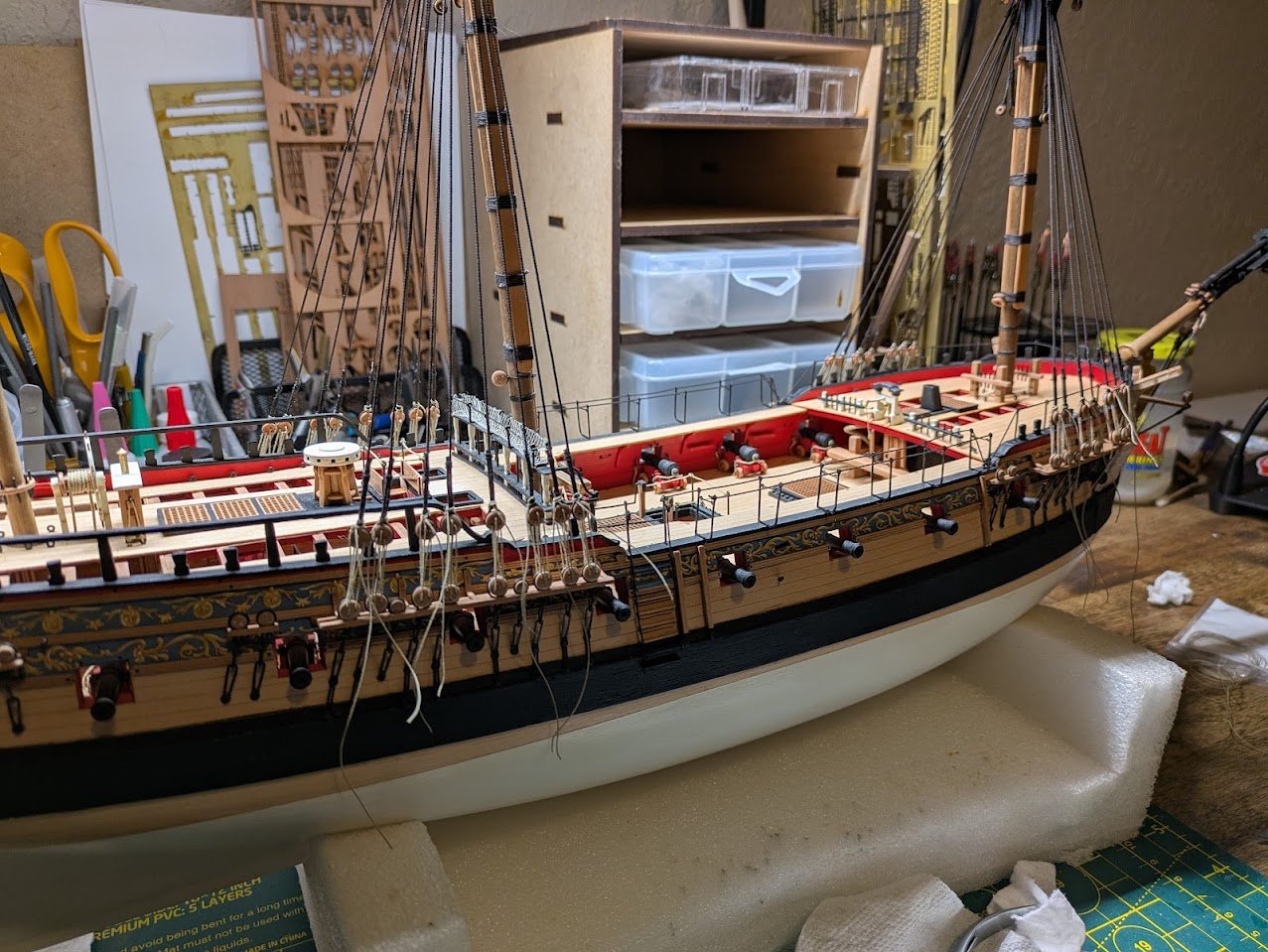-
Posts
329 -
Joined
Content Type
Profiles
Forums
Gallery
Events
Everything posted by brunnels
-
Always nice to see another Pegasus log, its a beautiful little ship that I always enjoy seeing.
- 16 replies
-
- Pegasus
- Victory Models
-
(and 1 more)
Tagged with:
-
My instructions say the lines should be black. Are yours different? I know mine is an earlier kit as the instructions don't have the rigging section in the instruction booklet like the New Instruction PDF online does.
- 422 replies
-
- Vanguard Models
- Sphinx
-
(and 1 more)
Tagged with:
-
QD Hammocks: I finished sanding the sides of all the hammocks, after I removed a good majority of the gray wash that was blotchy. I think I am happy with the result and will probably move on. In the pictures they look much more grime ridden than they do in person, I think its the shadows from the masts and ropes making them look like that in the pics. As she now stands.
-
Main Mast Back Stays: Still working my way aft on the back stays. -I decided to stop at the main t'gallant stays to give me better access for the hammocks on the quarter deck netting. Quarter Deck Hammocks My plan on this model is to fill the QD and waist hammocks with netting and add hammocks. When I built my first ship the Beagle from Occre, I wanted to try my hand at making some hammocks. I used sail cloth to make the hammocks and I wasn't happy with how they turned out, the sail cloth was hard to work with and roll/fold into something that looked to scale, the finished result was super large hammocks that I wasn't happy with but I had sunk so much time into them I felt I had to use them, a sunk cost mistake many of us have probably made. When @Techtonic posted his Album of his Bellerophon model in the gallery section I was extremely impressed with his model and his hammocks really caught my eye. He pointed me in the direction of @tedrobinson2000 build log where he made a nice guide on making the hammocks in that style using FIMO Modelling clay. I won't go too much into the process as I pretty much followed tedrobinson2000's guide almost exactly. I was able to make up the hammocks pretty quickly, I made probably 50 in less than an hour. I used a Light Gray wash to try and tone down the white. These are still a work in progress some are blotchy in spots from me handling them, so I will go over the hammocks once more before I glue them in. I also wanted to make sure the scale looked correct, I like to use one of Vanguards figures to help me visualize the scale, sometimes thinks measure out one way and then look completely wrong at scale. Next came the test fit Here is my first test fit, nothing is glued down. After I had filled up half of the QD netting I quickly remembered that I had forgot to sand the sides of the hammocks flat. Here is how the hammocks look when the sides are flattened a bit with some sand paper. They fit much better, I was much happier with how they looked after sanded. With a figure to show the scale, I think as far as size they look alright, but please let me know if they look too large or small. I will probably have a few more tweaks before I glue them in, but I think i'm pretty happy with the result so far. Just need to tweak the wash a bit, and debate if adding any rope around the hammocks will be too large and out of scale. Jibboom Horses (Footropes) Deviating from the stays a little more, I decided to add on the Horses for the Jibboom. Between Lee's and David Antsherls Swan Class Rigging book I was able to come up with the dimensions of the rope, and how it might have been attached. I used an eye loop on one end to secure at the end of the Jibboom and the other end was wrapped and tied around the aft end of the Jibboom behind the Bowsprit Cap.
-
I appreciate all the likes and comments from everyone. Question on the backstays. Is there an order that the stays go on? I started on the foremast with the furthest forward backstay and working my way rearward while alternating between port and starboard pretty much in the same order the shrouds went on. But as some of the stays have deadeyes, while others have block and tackle setups, I wasn't sure if there was a distinct order they went on. Here is what I have done for each side of the ship on the foremast.
-
I tried out that cutting planking tool as well on my sphinx. Once I got the hang of the tool it worked pretty good for its purpose, I found that quantity and spacing of cuts matters more than the depth of the cuts. My biggest issue with the tool is if you sand too much the cuts start to show through the wood. I'm not the best at planking so I had to sand my stern quite a bit and a lot of my cuts started to become visible. I think the tool is fine for the first layer, but I won't use it beyond that on my next model. As you can see my stern still needed quite a bit of sanding at the time and the cuts were already starting to show through.
-
That AK Gold looks really sharp especially next to that red, I am going to have to order a bottle of that stuff.
- 36 replies
-
- Duchess of Kingston
- Vanguard Models
-
(and 1 more)
Tagged with:
-
Ratlines: For the past week I have been at work on the ratlines. The ratlines on my previous model (Occre Beagle) turned out not so great, so I tried a different method this go around. My method this go around has been 1) Tie all lines with clove hitches. 2) Go back over all lines to ensure knots are tight and lines are where they need to be 3) Secure all knots with diluted PVA glue. 4) Snip excess rope. This process seems to have worked so far, none of my knots have loosened up on me like my last model. Template I am using, lines spaced 6mm apart. I still have to complete the Port shrouds on the main mast, and finish the port upper shrouds on the fore-mast, and then I will be finished with the ratlines.
-
Your model looks fantastic. I'm completely ignorant to card ship models, how much rope tension can they hold in the rigging process?
-
I normally love watching the squirrels in our yard, but they got a little too relaxed in my yard with no dog around, and one chewed straight through the power cord for my Traeger Grill. So now the pup is on duty keeping the Squirrels in the trees and giving them a good old fashioned stare down when they look like they are about to start any nefarious Squirrel business. Mizzen Top Stay: T'gallant shrouds and fore stays: Mizzen t'gallant stay connected to main mast top. Main T'gallant stay connected to foremast top. Foremast T'gallant stay connected to bowsprit. Next up is the ratlines.
-
I have taken Ideas from more logs than I can remember, but for the Sphinx @Blue Ensign's log is an obvious inspiration for my model you will see many ideas of his on my model, @hollowneck@Knocklouder's is another log I frequent especially when I am a little lost in the rigging, he has nice pictures of his rigging process. I also look at a lot of contemporary models of the period as an aid for how ships might have looked.
-

Advice on French 2nd or 3rd rate ship of the line
brunnels replied to James Flynn's topic in Wood ship model kits
It's a shame as well as there are some beautiful French ships, I was just looking around recently to see if there were any good 18th century French Frigate kits around 1:64 scale and sadly there wasn't a lot out there. -
Been working on the rigging whenever I have the time, but haven't been able to get any good modelling marathons in lately. I never know how to take pictures of rigging, so apologies if items aren't in focus. I finished up the lower shrouds with the mizzen shrouds. I will complete the ratlines at a later point. Once the lower shrouds were done, the lower fore stays were added. Next up I needed to complete the futtocks shrouds and catharpins before I could continue up the mast with rigging. My Occre beagle kit basically just handled the futtock shrouds by trying one end around the deadeye and the other around the mast, so I was a little intimidated by how much more complex these were. Once I started the task was more straight forward than I was expecting and went together pretty smoothly. The upper shrouds were my next task. I forgot to take pics during this process, but these are all very straight forward. Next I started the crowsfeet. I was going to do the upper fore stays first, but realized it would probably be easier to do the crows feet before I had the upper stays hanging over them. Crows feet are another task I have never done, so it took quite a bit of time studying up how to do them, once you get the hang of the order the crows feet are very easy to string up, the hardest task is figuring out where to start and end. Now that the crowsfeet are completed, I was able to start on the upper fore stays for the foremast, there is always something enjoyable about tightening down a series of blocks and tackle. The spare rope is temporarily hitched around the timberhead on the bow at the moment until I lookup how to secure ropes properly to the timberheads. Lastly I started on the upper fore stays for the main mast. Here is the block and tackle for the stay. Next up is completing the fore stays, ratlines, backstays, and then I need to start on the yards before the running rigging.
-
It's been slow going on the ship lately. It's always a busy time of the year with the holidays, but we recently introduced a 9 week old female Australian Shepard into our home as our new dock yard dog. The majority of my time has been spent with the pup with getting a small piece of rigging completed here and there while she naps, if I have the energy for it. Since I last left off I have completed the masts and started the standing rigging. I needed a break from the lathe, so I will probably turn the other spars after the shrouds and stays are done. I made the mistake of gluing the topmasts in place, I then realized when I started on the shrouds, that made it difficult to loop the shrouds over the masts. Oh well you live, learn and improve your mistakes on the next model, It hasn't been too difficult to put a seizing around the shrouds to make a loop once they were threaded between the lower and top masts. Foremast shrouds and deadeyes rigged. I also rigged the bowsprit shrouds, I need to take some pictures of those. Mainmast shrouds in place.
About us
Modelshipworld - Advancing Ship Modeling through Research
SSL Secured
Your security is important for us so this Website is SSL-Secured
NRG Mailing Address
Nautical Research Guild
237 South Lincoln Street
Westmont IL, 60559-1917
Model Ship World ® and the MSW logo are Registered Trademarks, and belong to the Nautical Research Guild (United States Patent and Trademark Office: No. 6,929,264 & No. 6,929,274, registered Dec. 20, 2022)
Helpful Links
About the NRG
If you enjoy building ship models that are historically accurate as well as beautiful, then The Nautical Research Guild (NRG) is just right for you.
The Guild is a non-profit educational organization whose mission is to “Advance Ship Modeling Through Research”. We provide support to our members in their efforts to raise the quality of their model ships.
The Nautical Research Guild has published our world-renowned quarterly magazine, The Nautical Research Journal, since 1955. The pages of the Journal are full of articles by accomplished ship modelers who show you how they create those exquisite details on their models, and by maritime historians who show you the correct details to build. The Journal is available in both print and digital editions. Go to the NRG web site (www.thenrg.org) to download a complimentary digital copy of the Journal. The NRG also publishes plan sets, books and compilations of back issues of the Journal and the former Ships in Scale and Model Ship Builder magazines.




.thumb.jpg.b9147902815aef905e53ec93b1e0c0c4.jpg)
